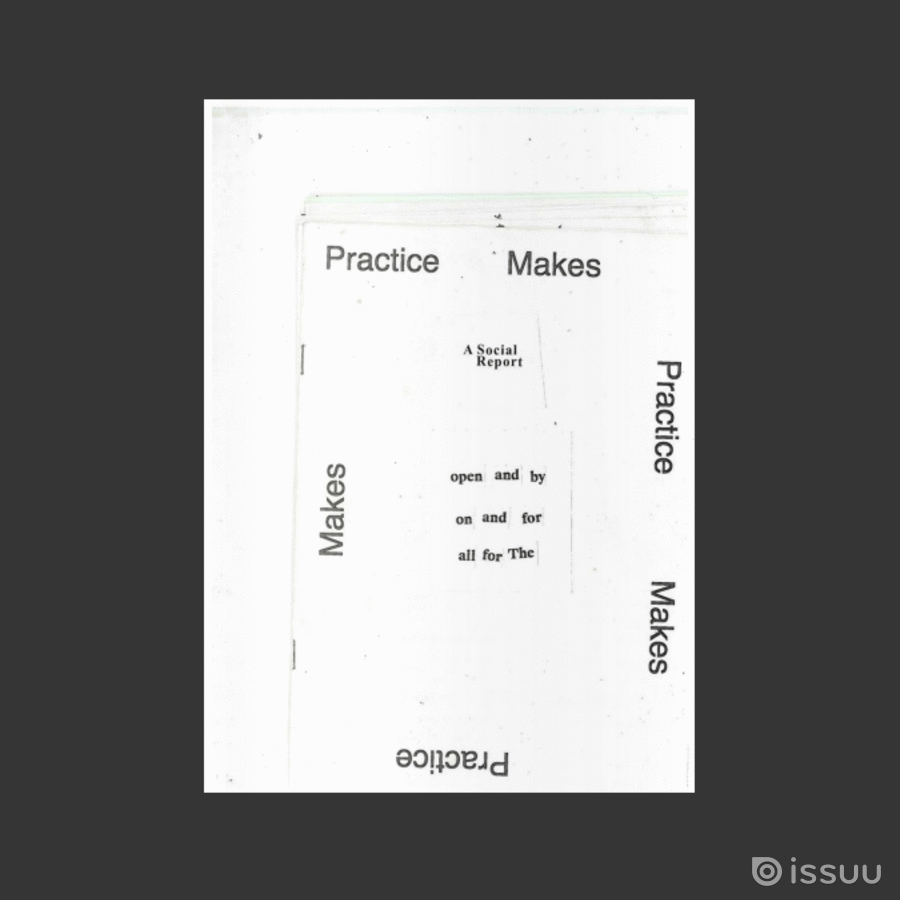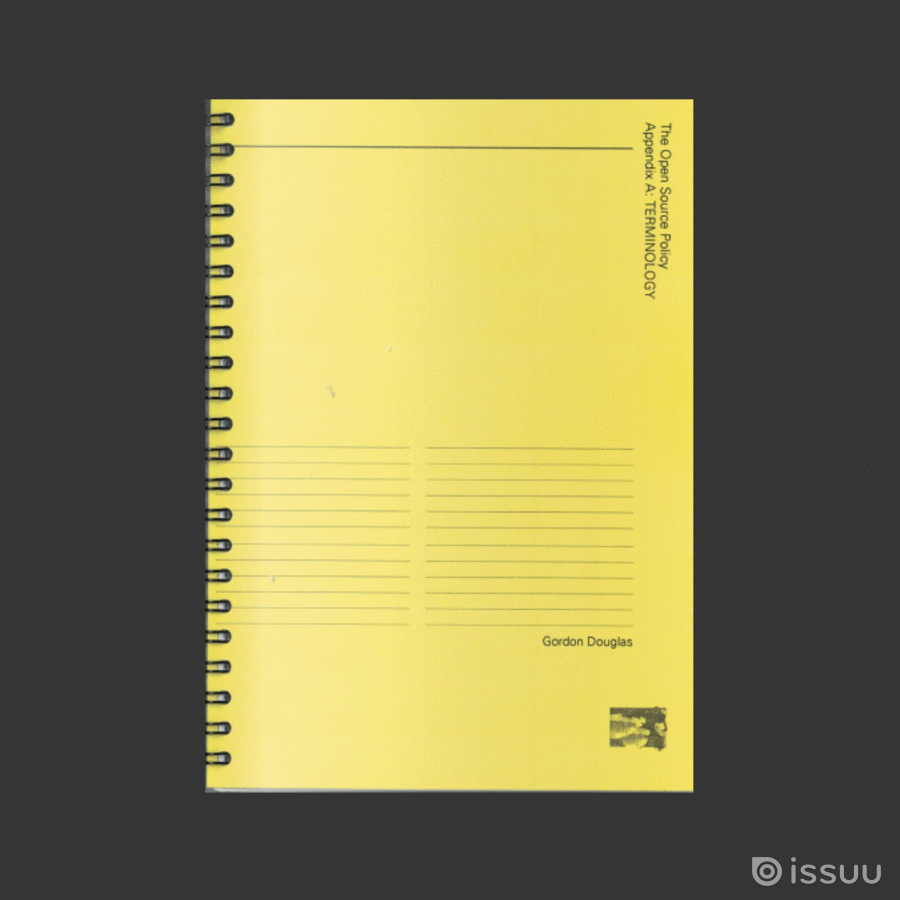Applications for this workshop are closed.
Dates: Friday 27 November — Sunday 29 November
That’s Governance! invites participants to work together and propose a non-human candidate to hold a position on Scottish Sculpture Workshop’s Board of Trustees. Applying games and exercises in deep listening and roleplay with puppets, the workshop will encourage a playful response and challenge to the perceivably immovable conditions of governing. What can we achieve by heightening our grasp of organisational advice from non-human actors, and what can we complicate by attributing social purpose to phenomena as critical or reformative tools? The workshop is open to participants with keen interests in performativity and who want to embrace further affinities with deep ecology, queer theory, actor network theory and alternative structures of governance.
The workshop responds directly to artist Jack Tan’s quotation that, “a truly queer, feminist, anti-racist, post-human Board would dance a tango with Governance– resisting, releasing, evading, acquiescing, rejecting”, and will expand outwards from SSW towards challenging broader conditions of governance. The resulting conversations and proposal will ruminate on the performativity of personhood, eligibility criteria and barriers to governing, anthropomorphic hierarchies relating to non-humans, and considerations within collaborative decision making.
-text from open call, https://www.ssw.org.uk/diy-17-2020-thats-governance/, DIY 2020: That's Governance!
In 2022, a shovel of dust off the floor was elected to the Board of Trustees following a nomination from the That’s Governance! (2021) working group. The group gathered on-site around a collective belief that other forms of existing, knowing and reasoning beyond human experience(s) are rarely included in how we construct cultural values, and make decisions. As a literal representation of the site, a shovel of dust off the floor will support in Board Meetings through a considered inventorying exercise– who is present at the meeting and who is not? The following letter written on behalf of the working group by Lead Artist, Gordon Douglas, outlines their proposal in full.

We, the working group, propose the following instructions in regards to how a shovel of dust off the floor can form a part of SSW's Board meetings:
- On arrival at the Board meeting, human Members of the Board will collectively sweep the floor of the meeting room, collecting the dust in a shovel or dustpan. The collection must be considered, observant and meditative.
- In the event of a remote or digital meeting, it is anticipated that the locations of Members are understood as extensions of SSW. Human Board Members will sweep or hoover dust from the floor where they are– each separate pile considered as part of a collective dust.
- Dust will be emptied from its shovel or dustpan, and positioned on the table next to its seat. On the occasion of other Members’ allergies, dust may be placed in a transparent container, such as a jam jar.
- A small, verbal inventory will be taken of who is present from dust at the meeting (hairs, pencil shavings, lint, plastic wrapping etc…), the inventory will be noted in the meeting minutes alongside other Board Members. No apologies need to be given for elements which may have not attended, however a reflection of what, and who, is in attendance at the meeting should be considered.
- Following the meeting, the dust may be returned to the floor, brushed back into the shovel or dustpan, or released outside. We anticipate that this will take some time, and believe that the duration of the exercise is significant in gaining access to visual and material knowledge of the organisation.
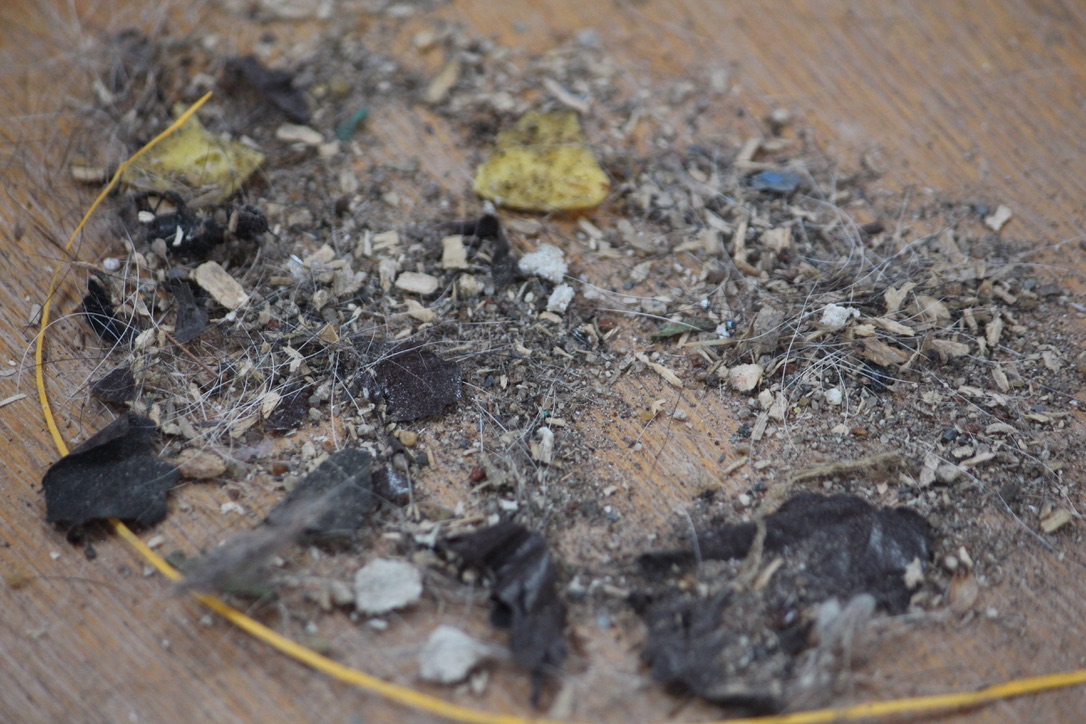
Gordon Douglas July-October 2021
Dear Dr Jen Clarke, Phil Chaplain, Dr George Jaramillo, Angela Main, and Stephen Murray,
I am writing as an extension to That’s Governance!, a session that took place at Scottish Sculpture Workshop between the 23rd and 26th April 2021. The session gathered a working group of five artists, thinkers and makers around an invite to collectively nominate a non-human candidate for a position on SSW’s Board of Trustees. As Lead Artist, I am writing to you today to formally propose that non-human to the current Board.
Our decision is grounded in a shared belief that other forms of existing in the world beyond our understandings of human knowledge and rationality are rarely included within governance models. In a climate of austerity characterised by exclusion, competition, territory and scarcity, we believe, similarly to SSW, that learning with and from the non-human is crucial to more interdependent decision-making, and enacts fairer, more just and connected governance.
In this letter, we resist popular inclinations to anthropomorphise the nominee(s) in relation to a personified agency, or to produce a fable for how it might stimulate a common narrative. We will however speak of how we eventually selected our preferred candidate, what it was about their phenomena and associations that we felt would support the governance of SSW (see Appendix I - Some Phenomena), and how they might be brought into and interject in the Board of Trustee’s quarterly meetings (see Appendix II - Some Protocols).
The nominee(s) we are writing in support of is a shovel of dust off the floor.
The report intends to provide an analysis of the organisation, The NewBridge Project, through gathering and organising responses collected in September 2016 as part of A Social Residency. The main body of text is orbited by digitised appendices, documents to various workshops that took place throughout the residency. The main text deconstructs the empty-yet-common appraisal of the NewBridge that it ‘filled a gap’, whilst drawing attention to the eccentric users of the building, suggesting that the organisation should look to the irregular studio practices of its studio-holders for internal criticism.
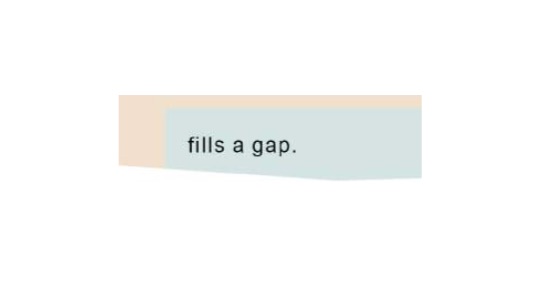
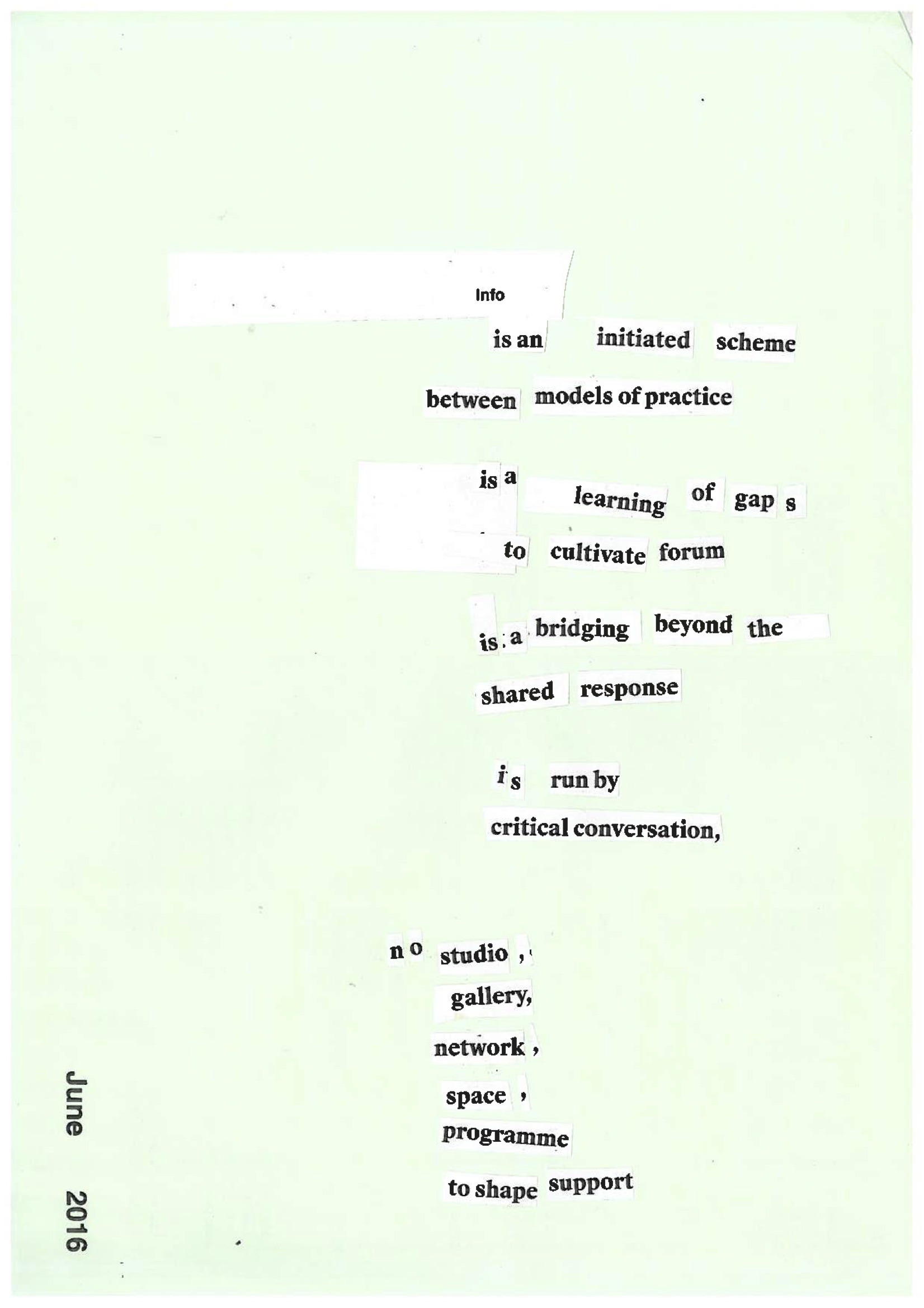
Dear Rebecca et. al at NewBridge,
Thank you for your patience!
Please find attached A Social Report, an attempt at criticism after falling for the charms of the organisation and the community that continue to labour it into being.
I hope it's helpful in some kind of way, I'm sure most of it is repeated matter that's already been established in conversations internally - but hopefully it was a useful act to consolidate it all in one place. The format is a larger piece of text in three sub-chapters: Anti-Social consultancy; The NewBridge Project Performs; and Overlooking the Gap. This is framed by appendixes, annotations, diagrams and digitised notes from various meetings.
As I've said it became quite a challenge to embody criticism due to the position I grew into, so I'm happy to talk about any of it if you have any questions.
Hope you're all very very very well, and speak soon I hope, Gordon xx
Out of eighty studios in The NewBridge Project, it is often stated that people only saw twenty-five or so artists on a regular basis. There is a tendency for artists who use their studios more regularly to develop frustrations for those who are less visible in the complex. All studio-holders are expected to perform to certain community standards, contribute to the general respect for contemporary art production, and not hinder the development of fellow artists. This is in exchange for the relatively cheap studio rates, and is characteristic of a lot of semi-professional economic relations. A logic system serving the needs of sculptural production ensures that everyone in the studio complex pays a flat rate– no-one is penalised for the size of work they make. The rate is £16.50 per week, with 80 studio artists generating an income of £68,640 per calendar year. One studio artist pays £858/year for a studio space. This goes towards funding the work from the core administrative team who deal with: the co-ordination of the programming committees; fundraising for projects; maintaining the building; and more recently, securing new premises after the eviction from the NewBridge St W site in March 2017. The following case studies are accounts of studio practices that reside in the studio complex.
A Studio-Visit Romantic brings back lovers to their studio after nights out where they have uncomfortable sex in a convenient city-centre location. Having held a studio since they were set up, their practice is now almost solely supported by regular studio-visits held with one-night stands. Dates are also shown around the project spaces and galleries on their visits, whilst A Studio-Visit Romantic provides interpretations and commentary about the works on show. This self-initiated public engagement programme provides an insightful criticism of the responsibility in maintaining that relationship between studio holders and the public spaces of the building.
A Pen Named Subtenant is the most infuriating of critics. They regularly hijack the waiting list for studios, renting multiple spaces under different names. They post and market the spaces online, letting them out for a profit. At present, The Pen Named Subtenant co-ordinates half of the spaces in the building, making it very difficult for the administrative staff to keep track of who has access to the building’s facilities. The profit from each of these studio spaces goes into funding a separate, competitive, administrative facility within the studios, catering only to those who pay for the higher-price studio spaces.
Dry After Hours has installed red lights, work surfaces, photographic enlargers, chemical baths, and shelving units (to store paper stock) in the bathrooms on each floor. After sundown, all the plumbing is turned off, and the toilets in the building alternate their use into dark rooms. These are used by the burgeoning fine art photography community, and have been pivotal in securing productive and generative spaces for this method of practice to flourish. When it is darkroom hours in the complex, other studio holders use the 24/7 toilets at a nearby, well-known fast food chain. When the sun rises, the darkrooms once again return to bathrooms.
Protect & Serve are a film-making duo who have converted their space into a television studio control room with screens covering each of the walls. They have positioned live feed cameras all over the complex, and are recording and broadcasting the day-to-day life of the studio community. A production company has purchased the rights to the footage and is producing a structured-reality television series with the studio community as protagonists. Protect & Serve survey the capturing of footage from their space, and have been able to construct several situations over the course of their residence. These structured situations are set-up to produce more interesting footage where studio members fall in love, develop friendships, philosophise, get confused, argue, raise boundaries, make enemies, ostracise community members and cultivate ideologies.
From the notoriously-elongated, walnut table in their studio, the collective, Zoot Suits, churn out fundraising applications for the studio complex and the individuals who reside there. Perched on the edges of the table, they tap at their laptops, pinging email documents to one another: proofread, edit, submit. Zoot Suits take commission from each successful application and over time, buy out neighbouring studios so they can afford extending their table for new members.
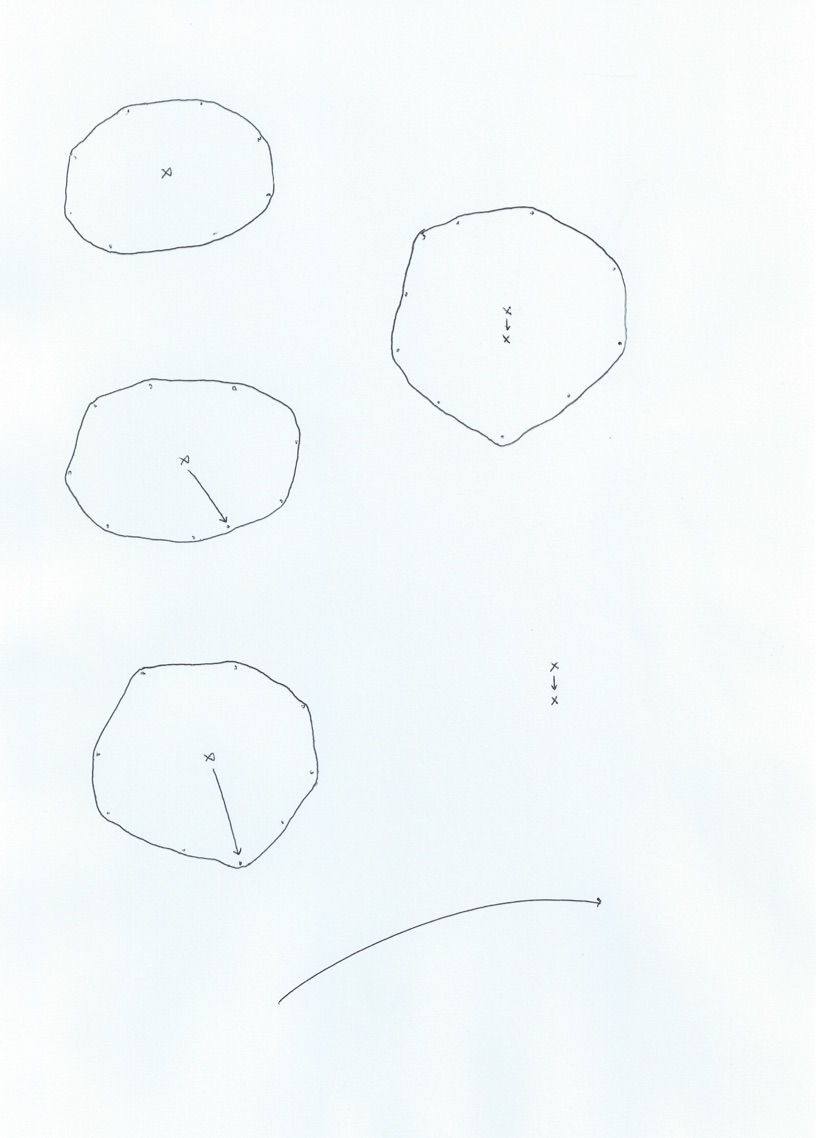
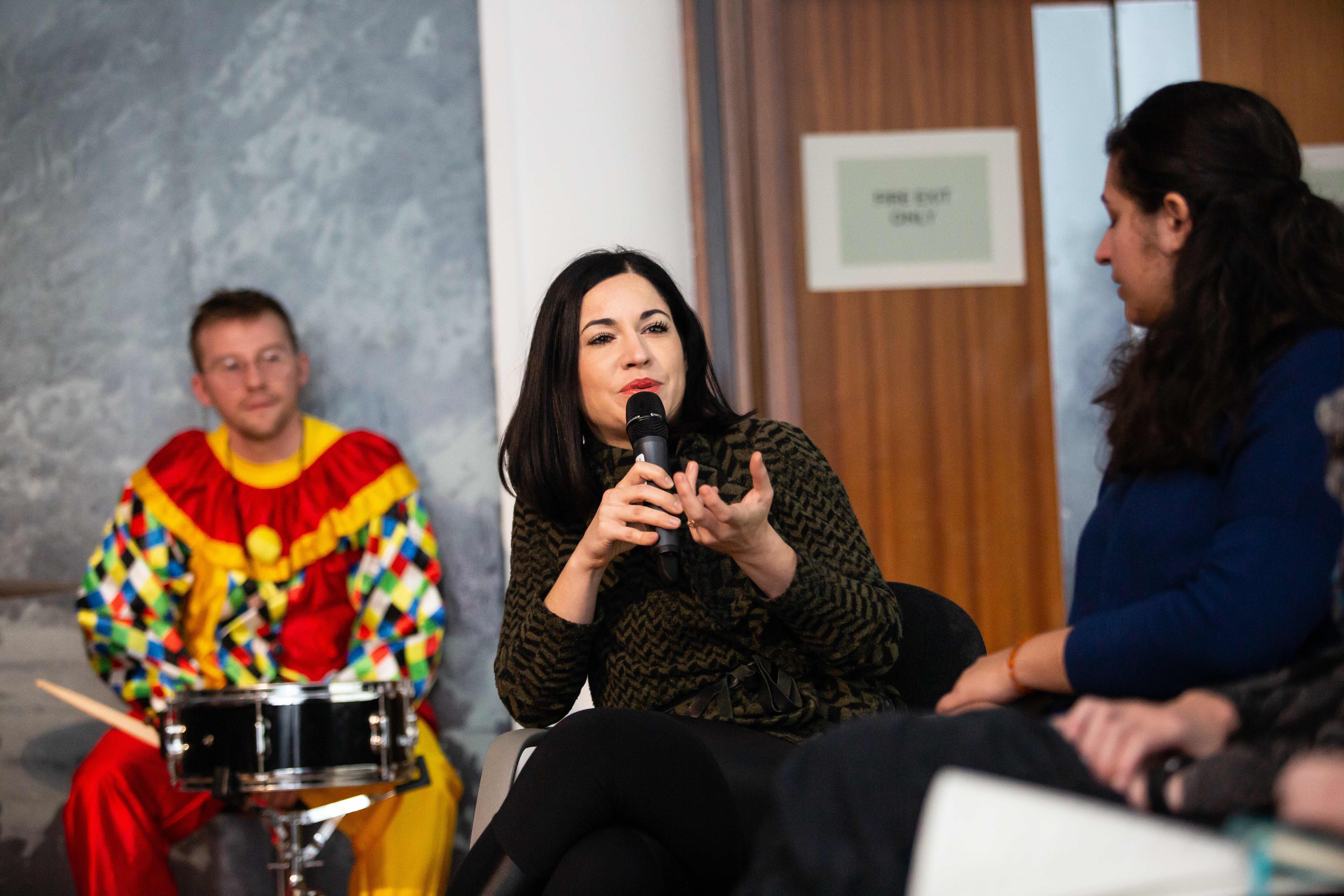 12-Hour Non-State Parade, Cooper Gallery, DJCAD, 2019, Image by Sally Jubb @sallyjubbphotography
12-Hour Non-State Parade, Cooper Gallery, DJCAD, 2019, Image by Sally Jubb @sallyjubbphotography
"Lovely Hallways (2019) reflects on the experience of mishearing the title of Neil Bartlett’s Love You Always (1990) when watching documentation of the work at the National Review of Live Art Archive. Bartlett is most associated with the NRLA for his role as Master of Ceremonies (MC), a position that assumed an ongoing responsibility of stewarding performers and audiences to the right places at the right time. As a flipside to the invisible labour, artist support and audience development contributed by Artistic Director, Nikki Millican; Bartlett’s MC appeared throughout the festival in the lobby, corridors and doorways as an intermediary and authority of the in-between– a drag character he describes as an ‘air hostess on speed’. The scheduled performance, Love You Always, is staged during Bartlett’s final year as MC: a hallways-ness interrupted by an always-ness. In the footage, we see people gathered in a dark room, and hear (/mishear) Bartlett announce the title as he stands in front of a giant, suspended, stone book, the words ‘Love You Always’ carved into its open-page spread. Beside him, a thin string of sand carries the duration of the performance, which ends with a thank you and applause."
[...]
Gordon would like to thank Julien Warren at the National Review of Live Art Archive, Bristol; Ainslie Roddick; Carrie Skinner; John Nicol; Carlton Studios; Annie Mather; in addition to the permanent and casual staff at Cooper Gallery for their continued generosity.
Gordon Douglas Lovely Hallways (2019) Commissioned Performance
Lovely Hallways (2019) reflects on the experience of mishearing the title of Neil Bartlett’s Love You Always (1990) when watching documentation of the work at the National Review of Live Art Archive. Bartlett is most associated with the NRLA for his role as Master of Ceremonies (MC), a position that assumed an ongoing responsibility of stewarding performers and audiences to the right places at the right time. As a flipside to the invisible labour, artist support and audience development contributed by Artistic Director, Nikki Millican; Bartlett’s MC appeared throughout the festival in the lobby, corridors and doorways as an intermediary and authority of the in-between – a drag character he describes as an ‘air hostess on speed’. The scheduled performance, Love You Always, is staged during Bartlett’s final year as MC: a hallways-ness interrupted by an always-ness. In the footage, we see people gathered in a dark room, and hear (/mishear) Bartlett announce the title as he stands in front of a giant, suspended, stone book, the words ‘Love You Always’ carved into its open-page spread. Beside him, a thin string of sand carries the duration of the performance, which ends with a thank you and applause.
[...]
Gordon would like to thank Julien Warren at the National Review of Live Art Archive, Bristol; Ainslie Roddick; Carrie Skinner; John Nicol; Carlton Studios; Annie Mather; in addition to the permanent and casual staff at Cooper Gallery for their continued generosity.
- Lovely Hallways (for 12-Hour Non-State Parade, Cooper Gallery, 2019) Lovely Hallways (2019) involved dressing up in an oversized harlequin costume, sitting on a drumstool behind a snare drum and cymbal for the duration of a 12-hour symposium, introducing speakers and panel discussions, and maintaining the smooth operation of the event by taking a very human approach to timekeeping responsibilities. I was positioned in the centre of the stage, with the hope that my comically exhausted appearance would phase between visibility and invisibility. Moments included speakers arguing back with me about their their allocated time and stating my timekeeping was censorship; acting as filler as we waited for our next performer by recounting everything I could remember about the architectural history of the narrowing hallway; and refraining from using the drum and cymbal to ba-dum-tss. Photo credit: Sally Jubb photography
Introduction-to-Performance is a course elective on performance art history that I devised with students of HND Contemporary Art Practice at Edinburgh College. The course borrows a theatre shortlisting method from Total Theatre Awards in order to evaluate and distill a longlist of 150 pre-selected performances into a group-generated list of 10 ‘good’ performances. Each week, members of the group are issued four works to independently research for the following week. Individuals return to share their four works to the rest of the group through storytelling, presentation or re-performance with one condition that they must not use supporting images. The individual chooses whether to discard or nominate the work for further discussion, at which point the work is, respectively, either dropped or designated to another member of the group for further research. The following week, the two discuss and argue the character, intent, craft and affect of the work, and decide together whether or not to nominate it. As the list distills itself, an increasing number of group members gain knowledge of the remaining material and are able to participate in the decision-oriented debates. As much as it is a performance art history course, it is also an exercise in how we process and police subjective value decisions as a group. The website was designed and coded by Ben Callaghan, an artist based in Edinburgh, as both an archive for what took place in the sessions and as a performance score so the course could be re-enacted.
WHY ARE YOU WRITING THIS SO LATE?!
I began writing this one week before Introduction-to-Performance Vol. 3, two years after Vol.2 took place, and between March and May 2021. Sketching out answers to these questions felt important before wrestling with an entirely new edition. There is no time limit on writing these Performance Reviews, although it’s important to state that the previous one was written within two months of Vol.1. I understand that I may have set expectations though, and I apologise that I am answering these questions later than anticipated. As well as there being other work commitments that I can use as excuses (Vol. 2 took place in a heightened period of activity that included: performing Welcome Speeches 1-3 (BALTIC 39, Newcastle, 2019); publishing A Working Thesaurus for Collaboration (2HB Vol. 23, 2019); and completing the year-long embedded research project, An Opposites Programme (CCA Glasgow, 2018-19)), it has honestly felt like two years has been the necessary time to fully unwrap the event in a manner that it really needed.
Punctuality and its relationship to shared labour time was increasingly significant in how our session unfolded. Given the compression of hours from a ten-week course into a two-day course, the management of time was key in ensuring our ability to cover the full longlist. As all our activities took place in the same room, it was important to mark divisions with time. I subdivided each six hour session into short bursts of individual research, small group clusters, larger group conversation, rest-breaks, socialising, and time for eating. To mark the transition between each of these segments, an iPhone timer alarm ‘Time Passing’ was used, and it would echo from the tinny speakers around the double-height room in phases of 10, 15 and 20 minutes. The simulated xylophone became our workers’ bell, and through its attribution as this, accidentally summoned the same threats we might face as workers for being late: disciplinary action, pay cuts, loss of privileges, demotion or dismissal. There was no punitive measures adopted by myself or the process for being ‘late’ in researching or in making decisions, but the social coding of the room and the ‘collaborative’ nature of the work implicitly demanded that participants attune themselves to the strict and shared rhythm. The threat of lateness was present in the room as a social exclusion– you might look lazy, you might look inefficient, you might look untrustworthy. Being late had more to do with the group’s perception of your character, impacting on your standing in the group, and threatening the legitimacy of your values and opinions. The nature of researching whilst visible also will have impacted group expectations of you and your work ethic, potentially causing some of us to perform our research - our body language curled over phones, a studious attention to taking notes, and facial expressions that might ponder the philosophies of new encounters.
Looking back, the speed at which we were operating (and the way in which the policing of time became a collective responsibility) might have instilled a sense of time pressure associated with the gig economy or the pace at which Amazon employees might have to pick stock for quick despatch. The process became so much about churning out knowledge and decisions, and lacked the time resources to sensitively consider the works we were engaging with, and reflect on how we made those decisions. I am disappointed with how un-discussed some of the works were in this forum, with the full longlist of 120 performances aired and exhausted in 12 hours.
2. Please describe your working context.
From 2008-2010, I was a student at Edinburgh’s Telford College (now Edinburgh College), a further education institution in the North-west of Edinburgh. I was studying the HND Contemporary Art Practice course, a course born out of HND Public Art, and designed by course leader, Alan Holligan in 2007. In 2016, I applied and was successful in assuming the position of Artist-in-Residence as part of the airETC... programme, an initiative inviting graduates of the course back for the reciprocal benefit of all parties involved. As well as successfully building rapport between succeeding year-groups of the course, the programme offers opportunities for professional development in the form of supported studio time and teaching experience. As part of the residency, I ran my own self-devised elective course, Introduction-to-Performance, in an attempt to: (1) provide a non-chronological approach to learning about performance art history; (2) expose students at an early point in their education to self-organised, morally diverse, and politically complicated practices; and (3) further understand the transference and development of mutually-held virtues within group decision-making. Like a lot of further education colleges, Edinburgh College was formed through the merger of previously existing local colleges (Stevenson, Jewel and Esk, and the already mentioned Telford), resulting in major cuts to preparation and contact time, in addition to the current national austerity measures placing teaching staff in precarious contracts. In response, staff uphold an active protest culture in association with The Educational Institute of Scotland, and are, at the time of publishing, on strike.
Just thought I'd make a preliminary post with details for everyone, and so that we have everything in the same place. I'll put this all in the Description section of the page which is almost invisible on the right hand column of the page:
METHOD: The method is adapted from a theatre shortlisting process used by Total Theatre Awards which I was part of in August. I have created a longlist of 150 performance works from the 1950s to now. Each week, we will individually take responsibility over researching 4 works from the list and research these specific pieces. I will co-ordinate this from my already admin-heavy practice. The following week, we will return to the group and share or re-perform the works we have researched for the benefit of the group, either mediating through voice, body, storytelling etc, no images though. It will then be the individuals decision whether the work they have researched is worth nominating for further discussion in the next round. Nominations can be either because the work is of outstanding quality or the individual is unsure about it. If a work is nominated I will delegate it to another member of the group to further research for a second point of view. I'll get to use my fancy spreadsheet for this. The next week, that person will return and share their take on the work, opening up a dialogue. If the work continues to be nominated, more people will be researching it and the dialogue will evolve into a deep debate around the values of that work. If a work is not nominated, it will not be discussed again. This process will continue until we reach a shortlist of 10 that best characterises the groups values around what constitutes excellent performance work.
RESEARCH: I'd really like for the research we conduct to be available to the public in future, so if possible can you copy/paste links to the fb page or to the tumblr I've made as well (introduction-to-performance.tumblr.com) (I can add you as users if you'd prefer this so you can upload directly to here). It'll be a continued resource not only for each other but for other people interested in performance - there currently is no fundamental performance index online that I have found, so we may generate a really useful tool.
RESEARCH TIPS: Some of the works in the list are not traditional performance art works, with personas, web presences, protest movements, lectures, organisations being included in the curriculum. For more contemporary works, it's sometimes best to search for the artist's website, then navigating through there to find the work. If you really struggle to find anything about the artwork please get in contact. I've gone through most of them, and there should be some sort of google hit when they're searched. Images very rarely give a holistic sense of a work, so it's a good idea to cross-reference researches with video and sound streaming websites ubuweb.com, vimeo, youtube, and soundcloud. There are often videos (either professionally produced or fan-generated) that can be really insightful for understanding the works. If there's a video online that's an hour or so, don't feel obliged to watch the entire thing - very frequently the documentation of them is not half as interesting as the live event. I should stress, this is not the case about all work though - the relationship between document and performance is an interesting balance. The History of performance art is essentially the History of performance art documentation.
DATES/TIMES:
- 16th November - 2:45 - 3:30 - Introductory Session
- 23rd November - 2 - 4pm
- 30th November - 2 - 4pm
- 7th December - 2 - 4pm
- 14th December - 2 - 4pm Christmas Break
- 11th January - 2 - 4pm
- 18th January - 2 - 4pm
- 25th January - 2 - 4pm
- 1st February - 2 - 4pm
- 8th February - Shortlisting Session
4pm is a loose marker, I understand a lot of you have other classes to attend, as the group sessions are primarily led through discussion and are aimed at developing language around performance art, classes may overrun/underrun. It's really important that we start at 2pm so that those of us that do need to leave can be as present to the conversation as possible.
PLACE: The MediaLab sounds like a very good option with sofas.
GUESTS: I've been speaking to a lot of performance artists, curators and educators about the class and some of them have seemed very interested in being involved. Some weeks we may have guests who will be expected to research and present four works from the list as well.
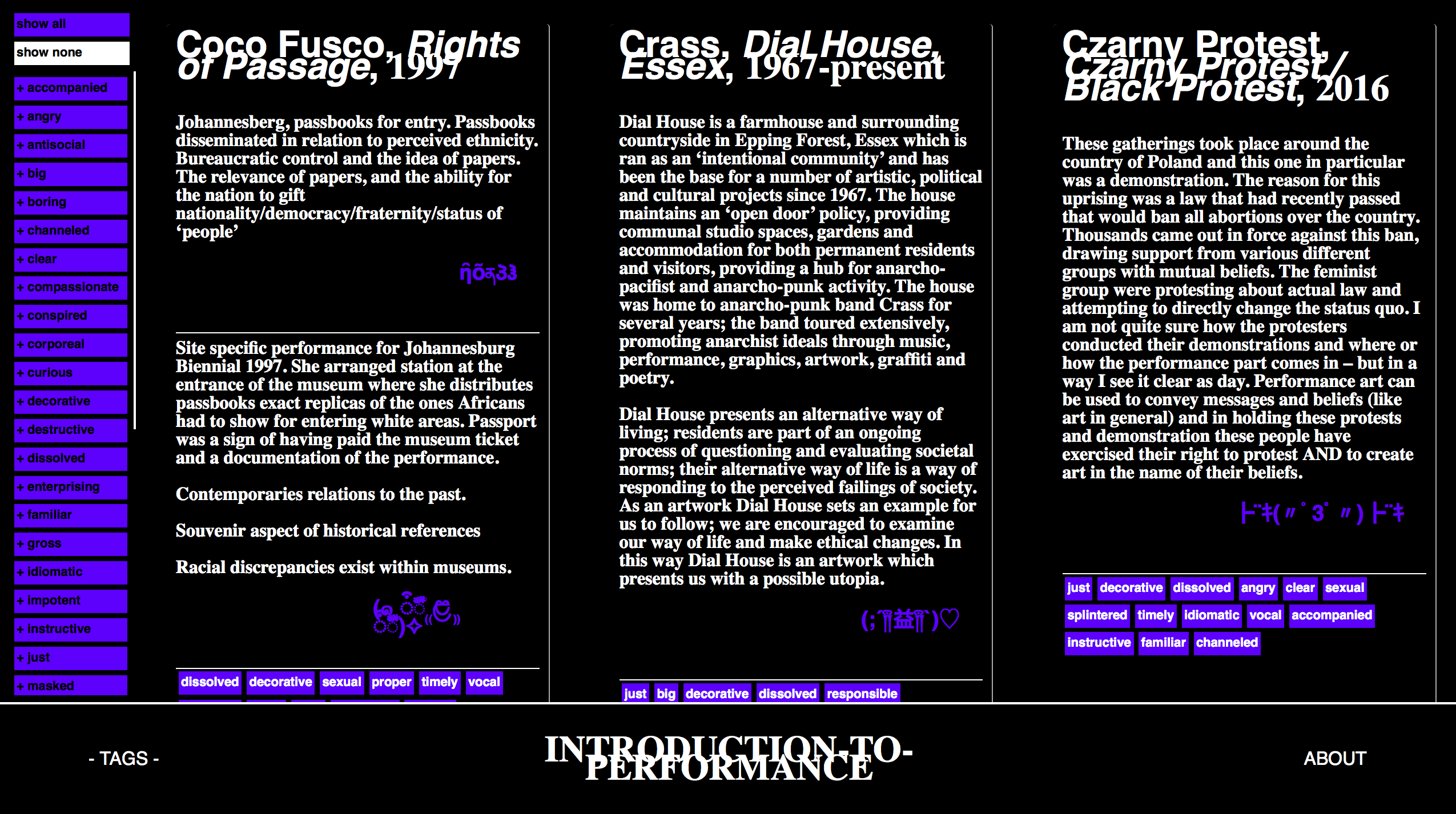 www.introduction-to-performance.xyz
www.introduction-to-performance.xyz
- website designed by Ben Callaghan
No School! Introduction-to-Performance Vol.2 Gordon Douglas
Saturday 11 & Sunday 12 May 11am—5pm
Booking required! Please book here via eventbrite.
Introduction-to-Performance Vol.2 is a discussion oriented, weekend long workshop looking at performance art histories from around the world. It has been devised by performance artist Gordon Douglas as part of No School!, Rhubaba’s learning programme inspired by desperate measures.
Drawing from the successes of the first volume with students of Edinburgh College, Introduction-to-Performance Vol.2 works from an entirely new curriculum– a longlist of 120 performances, actions, and protests that we will rigorously and playfully deconstruct. As well as being an opportunity to get reacquainted with the rich and diverse histories of performance, the weekend will be a platform to practice and gain confidence in speaking critically about performance in a fun environment.
Over the weekend, we’ll adopt a technique inspired by theatre shortlisting methods and popular education exercises, to debate the merits, ethics and values of performance works from the 1950s to present day. Through argument and conversation, we’ll collectively compile a shortlist of ‘good’ performance, showcased at an awards ceremony on the Sunday evening.
For documentation and information from the previous iteration, please visit www.introduction-to-performance.xyz.
Travelling Gallery is a custom-built gallery inside a bus that has travelled around Scotland bringing contemporary art to communities since 1978. Over the course of 2017-18, we worked together closely, thinking and talking about the pressures (and paradoxes) of performing resilience in the context of austerity in the Scottish public art sector. As well as being Travelling Gallery’s 40th Birthday celebrations, it was also a year that saw the organisation’s funding cut, threatening their capacity to deliver exhibitions and tour each year. Black Box Take Stock was built around these two, divergent futures: a future built around the collective will of the organisation’s diverse audience, ‘here’s to another 40 years!’, and a second, more pessimistic projection that saw the organisation succumb to austerity.
One really fruitful thing that came out of our conversations was this tendency in this climate for arts organisations to anthropomorphise themselves, to manufacture a psychology that matches their performance. Birthdays seemed like a way of talking about that through a subject matter that was almost universal. I commissioned a personalised birthday song from a professional birthday-telegram, Mike Collins, who we organised to meet us in various spots around Scotland. Locations included: council depots, gas stations, bus garages, and other parts of the infrastructure that host the gallery when it’s not ‘open to the public’. We had the bus do these manoeuvres around sharp corners whilst Mike and I followed it as if in some odd medieval procession our performance being filmed by the existing reversing camera. The driver, Andy, used to work in film and television, so he knew lots about tracking shots, and it felt like this really poetic way of temporarily bringing these two jobs together.
Well, I have a little tale to tell, In this minstrel’s song, About a Scania Omnidekka Chassis, 3.5 metres tall, 12 metres long, And it travels around the whole of Scotland, Brings contemporary art to communities To town centres, schools, community hubs, Care homes, prisons and libraries.
CHORUS
So Happy Birthday to the Big, Beautiful Bus, You’re 40 years old and we all agree, Some newspapers call you ‘Art in a Bus’ But you will always be the Travelling Gallery
Now Andy and Rab are the drivers, Jo does Education, and Claire does curate. Sheila and Vicky are the administrators, There’s been lots of volunteers since ’78. And Graycoll are the mechanics, who service the bus, The engine rumbles and the generator whirs I hear, There’s no air conditioning or heating inside, No uniforms, just hi-vis jackets that they wear.
So Happy Birthday to the Big, Beautiful Bus...
Now the gallery has existed in three separate buses, Over its 40 year history, The first bus was touring in ’78, And then a custom built vehicle in ’83, The current bus was built in 2007, The design and purpose of the gallery are still the same today, Well you don’t have to fix something that’s working, No need to re-invent the wheel anyway.
So Happy Birthday to the Big, Beautiful Bus...
And while they were installing the last exhibition, A pick-up truck reversed into the bus they say, Smashing the windscreen and the front bumper, So they took it to the garage and there it had to stay, And people came from far and wide to see, Engaging, inspiring and challenging art, And while the mechanics worked on the outside of the bus, The big beautiful bus stole our hearts.
So Happy Birthday to the Big, Beautiful Bus...
- The following is the Editorial I wrote for CCA Glasgow's unpublished July/August brochure. The printing and distribution of the brochure was cancelled due to CCA’s closure (June 15th - October 13th 2018), following the GSA fire.
At the time of writing, I have had a desk for two weeks and it is almost two months until we publish. In advance, I’d like to apologise if I misconstrue or complicate things with different tenses, I’m writing from two different positions in time and I’ll attempt when redrafting to at least get things standardised to one of those positions. A similar temporal disjoint is happening on the clock in the office– it’s currently 10:13am but the hands are reading 5:02pm. It’s both the start of the working day and quitting time.
My name is Gordon Douglas and since May 2018, I have been embedded in CCA, working towards a ‘performative audit’ of their open source policy, a policy that allows the free and temporary use of CCA’s spaces and resources by the organisation’s wider community. An Opposites Programme is the realisation of this audit– a series of in-house workshops, discussions, public events and performances. The events seek to challenge or push against barriers of access, individual accountability, and economic precarity within the programme; auditing the policy through generating activity within it. The project has developed from a vested interest in collaborative working models, and the kinds of performance that take place in order to maintain these structures. Since 2015, I have been working closely in partnership with organisations of different scales towards looking at performativity and reproduction in collaborative and organisational practice. Drawing from the rich histories of institutional critique and queer performance, I’ve been co-ordinating events in pursuit of space to talk about the invisible nuances within collaboration. These partnerships have worked closely within (and sometimes against) drives to future-proof, and strategies for adapting within a deepeningly austere political-economic context.
Two months ago, I’m tapping fingers on a desk to the sounds of Total Leatherette inching into the office from the Creative Lab. I’m looking down at an open copy of Elias Canetti’s ‘Crowds and Power’. Fitting into less than a page, the sub-chapter ‘The Hands and the Birth of Objects’ talks through the repeated enactment of hand gestures until these gestures are crafted into being:
“The hand which scoops up water is the first vessel. The fingers of both hands intertwined are the first basket. [...] Before early [people] could create it [themselves], [their] hands and fingers had to enact it. [...] Words and objects are accordingly the emanations and products of a single unified experience: representation by means of the hands.” (Canetti, pg 254)
The recurrence of go-to actions is the rehearsal of an object, then a substitute technology that we use to streamline the process indefinitely. Within the process of enacting rhythms, there’s a promise of a future– a perception of the rhythm followed by its subsequent expectation. In the case of the social institution, protocol is one way of formalising these practices; policy is another.
Throughout the first two months developing An Opposites Programme, I’ve been thinking a lot about the performance of rhythms within the CCA, patterns that help administrate the multitude of activity welcomed and hosted through the open source policy. Steady punctuation like the exhibitions programme, marketing brochures, and operations meetings seem to be the most concrete of these rhythms. As part of a series of meetings to discuss the future of the organisation, we also looked at the micro-performances within the daily routines of all stakeholders. Alongside this, I’ve been attending meetings with open source partners, annotating governing documents, shadowing specific jobs, and speaking with previous contributors to the programme. These first two months have aimed to develop a clearer picture of what is happening, and how this technology is operating.
In an attempt to make sense of the simultaneity of performances, I’ve been developing alternative approaches to minute-taking: a bouquet of flowers that breathes and decays in the staff room; an anemometer that measures the movement of air within operations meetings; dust that gathers in underused parts of the building. The minutes are a way to annotate the goings on at the CCA, and seek to identify non-human relations and institutional byproducts as stakeholders. Rather than having the relationship to the temporal measurement of minutes in an hour, the etymology of the term minutes comes from the latin phrase ‘minuta scriptura’, literally translating as small writing. I want to think more about how ‘small writing’ might relate to ‘fine print’, overlooked or hidden stipulations in a contractual arrangement.
I sit back from the writing, look over to the clock. It still reads 5:02pm. The second hand caught ticking between 42 and 43.

.jpg) photo credit : Max Crawford
photo credit : Max Crawford
...‘Gordon is Our Wall’, a comically apt pastiche that kept rattling around in my head, became a phrase that seemed to capture that interface function that maintained and gave conceptual depth to the curatorial aspect of the project. The wall, the gate, and Gordon, all became flexible depending on the needs of the individuals and the territory they required. Thin films that abstracted and summarised the productivity of other partnerships, whilst directing individuals towards individuating themselves. Maybe it wasn’t a wall, but it was a gravity, or something that pulled satellites within this impossible vacuum. Drawing attention. A gravity which stemmed from the ability to expend energy.
In some ways, the prepaid card that I used as the promotional image for the project, felt like the only truly representative image generated by the project; or maybe it was the only image that served as document for the performance of sustaining this complicated network of production. It was the image of support, a comforting gesture that our decisions were right because they were funded. It was a semi-monitored tool that racked up expenses and packaged them for evaluation. It was the image of power, a private currency brought to every meeting. It was always only ever one, and therefore could only be walleted by one person.
I carried it, like I carried around the administrative duties of catching up with every partner. If invisible gravitational fields had something to do with it, then the card seemed to mask this vacuum– after all, the money that existed and was given to us didn’t really exist. Just digital numeracy. It was also a mask to the empty space occupying Intermedia that existed temporarily between the events. The conceptually airtight void, existing as an anti-rhythm between events, was a relatively frictive action in the context of the open-source policy. It was the subject of many emails between myself and the organisation, and a problematic that I will return to later.
I wondered if Elmgreen & Dragset had a joint bank account, if Chim↑Pom have a shared debit card? How about Guerrilla Girls?... Full blog post can be found here: http://www.cca-glasgow.com/blog/gordon-douglas-gordon-is-our-wall

.jpg) photo credit: Max Crawford
photo credit: Max Crawford
 (CCA Glasgow, 2019).jpg)
What is Ts and Cs in the squeeze?
Ts and Cs in the squeeze (FKA Writing Nothing Down) is a learning game that centres itself on a fantasy negotiation of contract agreements between invited Artist(s) and host Organisation(s). The game is based loosely on the mechanics of ‘Cards Against Humanity’, an offensive party game where two cards from separate decks are brought together to produce surreal examples of shock, or cringe comedy. Ts and Cs in the squeeze similarly comprises of two decks of cards each containing half of a clause or phrase you might find in an Artist’s Contract. Players attempt to collectively complete clauses together. It has been devised as a tool for myself (and potentially other artists) to be played at the start of collaborations and afford time for communicating individual expectations with the hopes of producing a more transparent working dynamic.
Writing Something Down after Writing Nothing Down, report following Jerwood Bursary, 2021
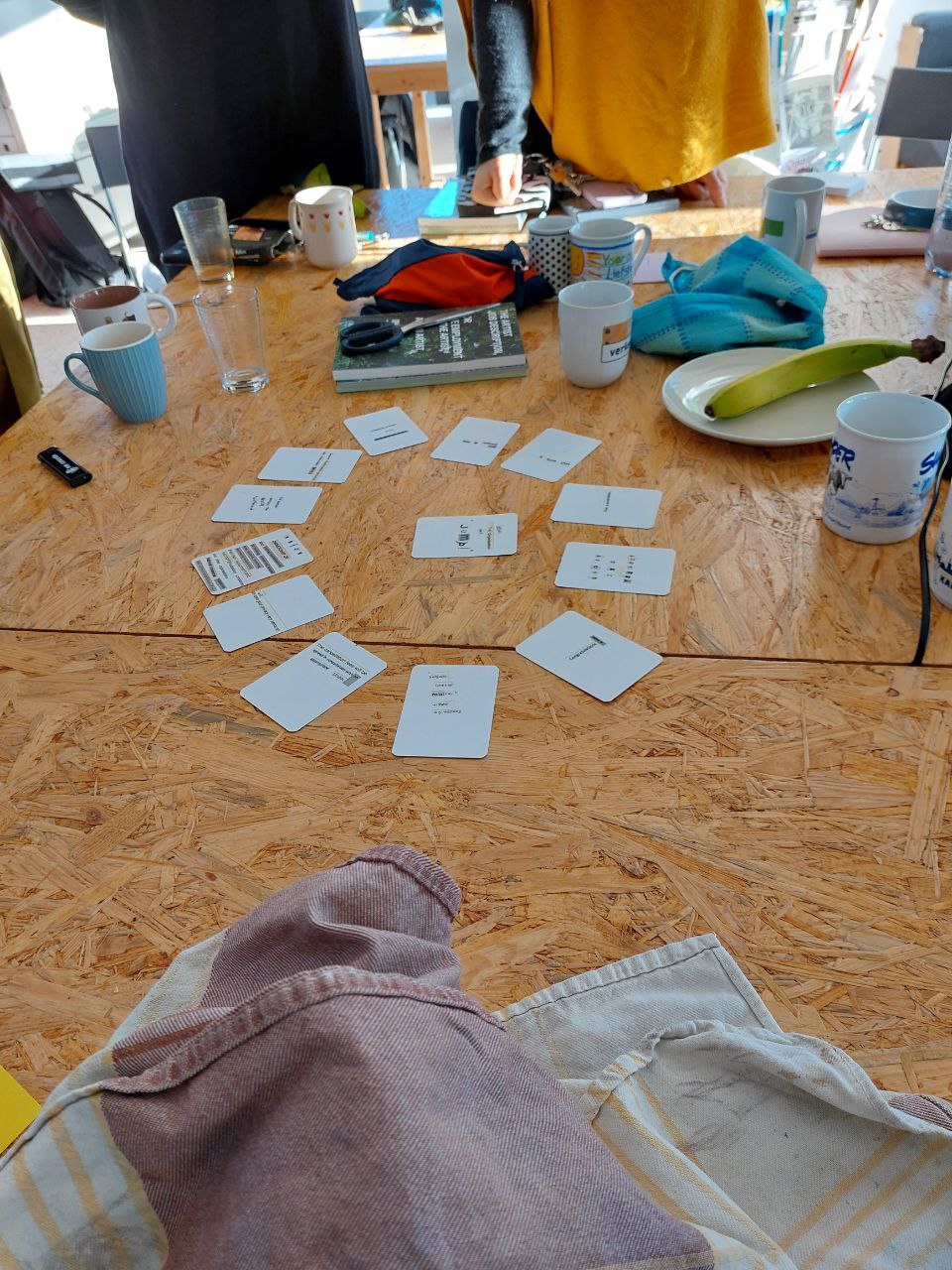 photo credit: Cristina Cochior
photo credit: Cristina Cochior
Ts and Cs in the squeeze (FKAIf this then that) is a card game to be played by artists and arts workers with intentions of working together. It draws from research into the form and grammar of Artist Contracts, regurgitating and collaging the history of signed, professional agreements within my embedded performance practice. Initial reflections followed a series of close calls within collaborative engagements, and strived to consolidate better working conditions for all in the form of a cooperative game.
Given the environment of competition, precarity and territorialisation that cultural austerity fosters, I wanted to offer moments of solidarity and transparency between artists and arts workers as we face this crisis together. The game was refined through rigorous playtesting at: Hospitalfield Arbroath; AdBK Nuremberg; and the arbitration of an agreement between artists and organisational staff with Collective, Edinburgh. In all cases, the game served as a memory device, stimulating players in offering stories or strategies when working through institutional complicity, commitments, ethical funding, and boundaries.
As well as being an index for players, the game documents my last ten years emerging practice: the sometimes naive commitments; the things I wished I’d said; and the truly meaningful relationships I’ve made with people across the country. [...]
.jpg) photo credit: Rachael Simpson
photo credit: Rachael Simpson

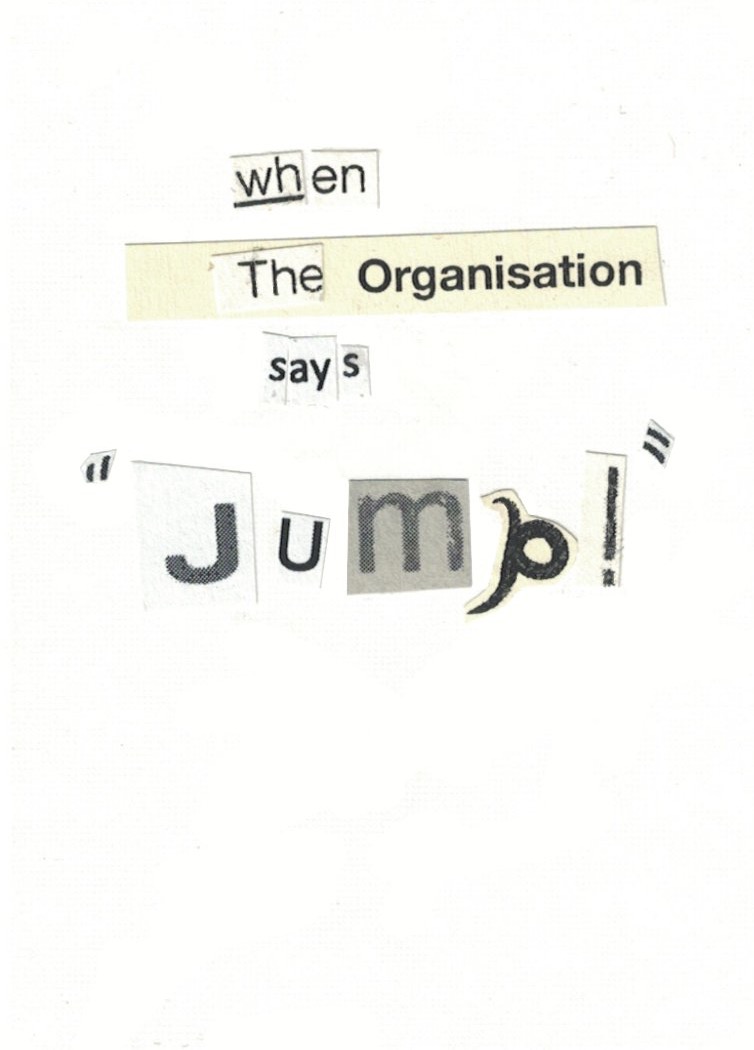
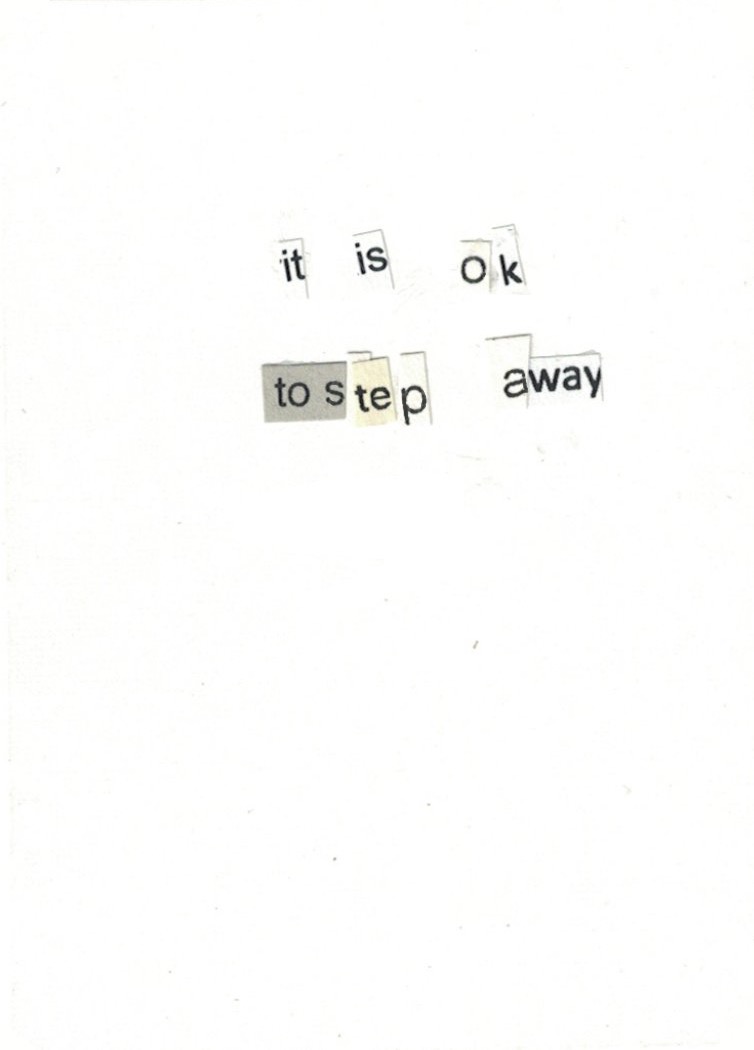
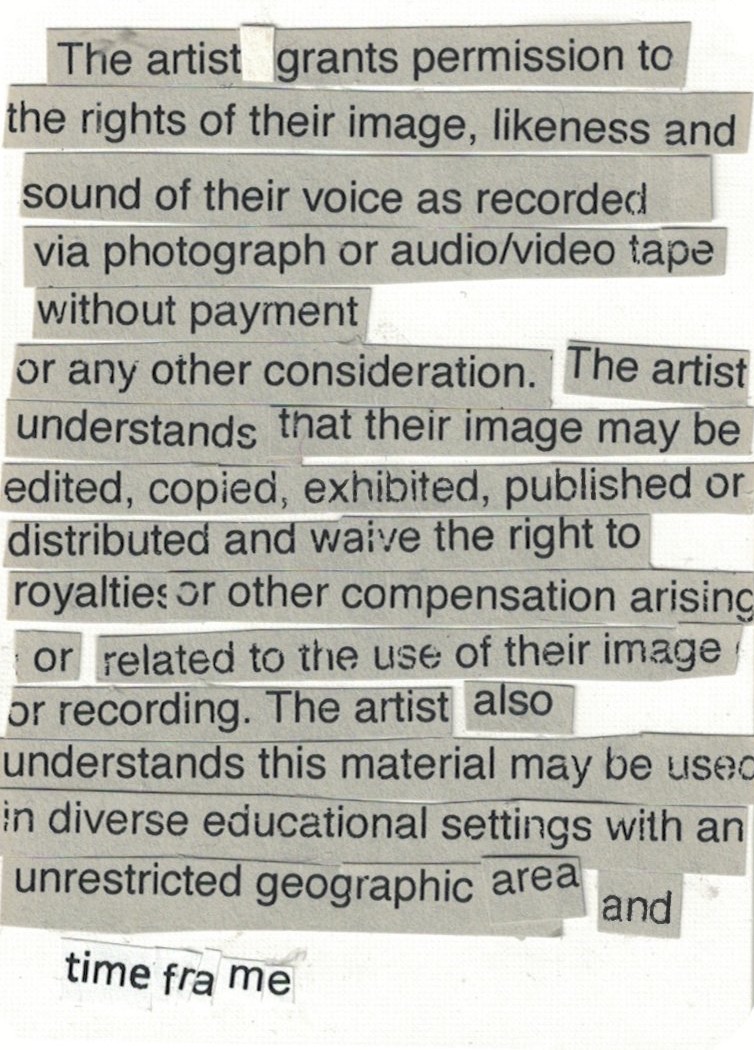
It’s called Writing Nothing Down, and the aim of the game is to collectively write an Artist Contract with two decks of cards, an if deck (20 cards), and a then deck (80 cards). It is for 2-6 players, ideally played in advance of an upcoming collaboration between an artist and host organisation. As an artist, you could play with representatives from the hosting arts organisation, each holding different stakes in the project (such as a Curator, a Director, a Freelance Technician, an Intern… etc).
To start the game, each player is dealt ten cards from the then deck as their private hand. One card is subsequently revealed from the if deck which all players can see. All players propose one then card from their hand as a possible completion of the if statement, and the players collectively decide (or compromise) on which card represents the will of the group. An Agreement is born!
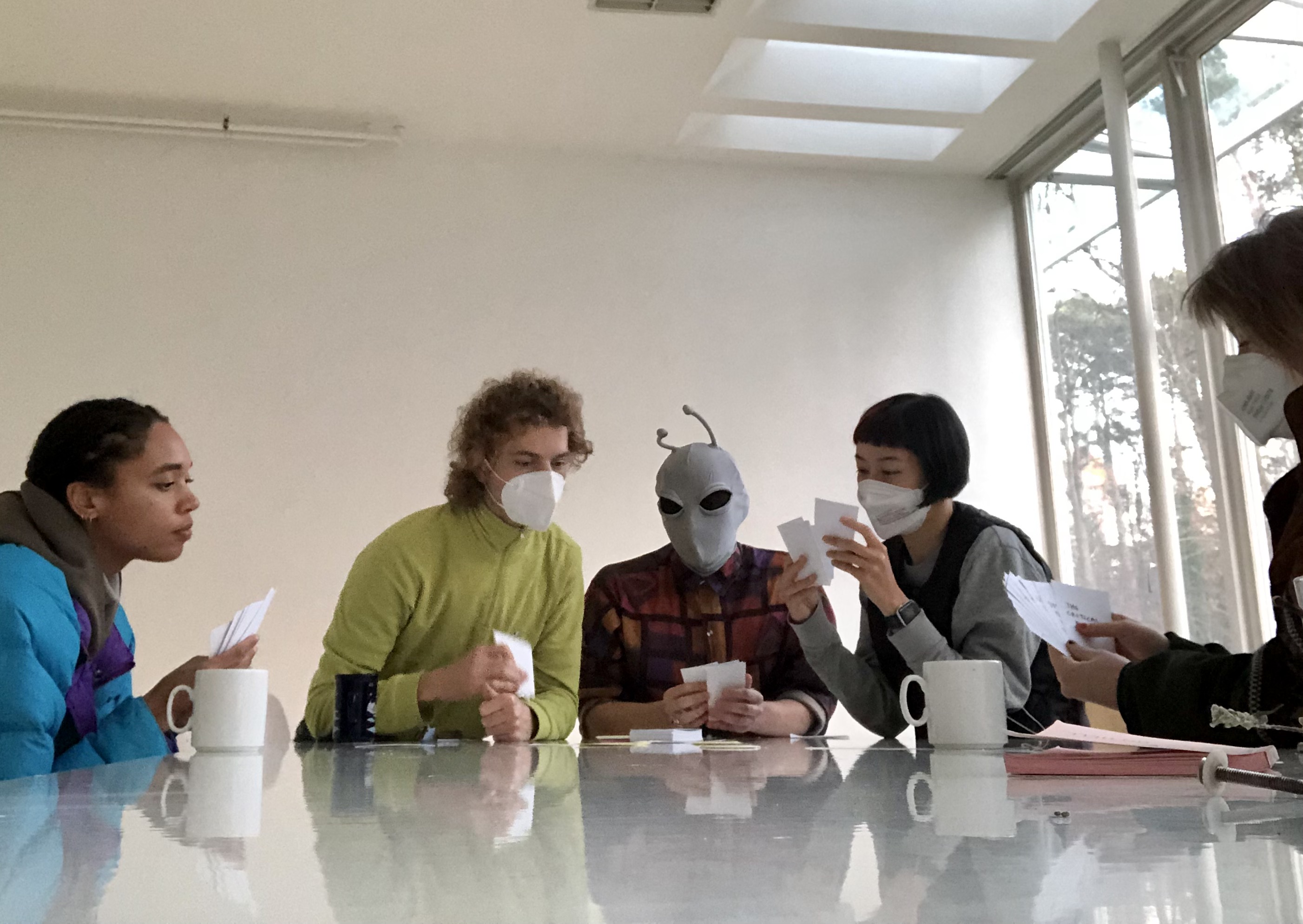
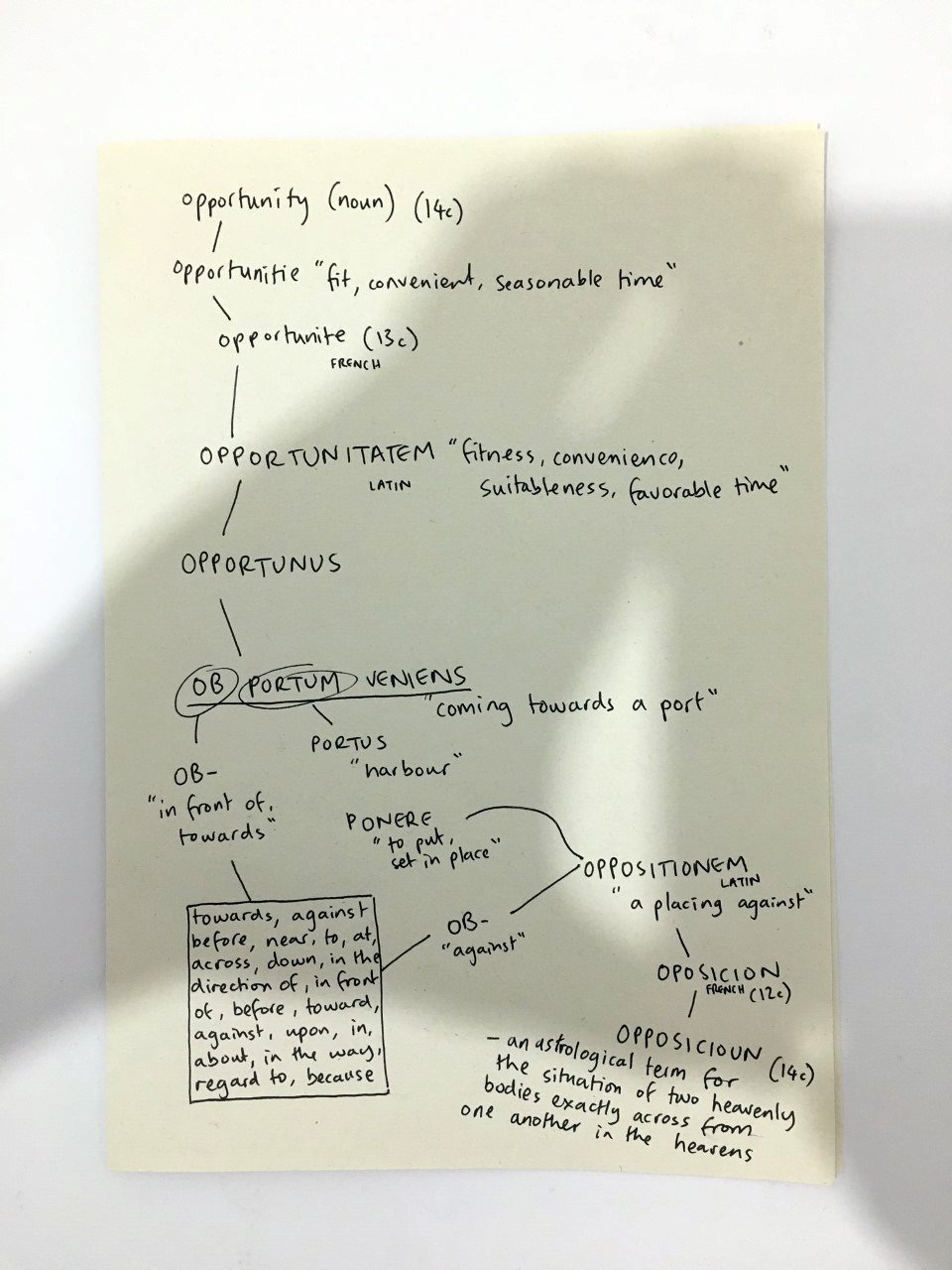
Twelve Months: The Opportunities Dice Game was originally devised for recent arts graduates participating in Embassy’s GRADJOB professional development programme. The game adapted and game-ified existing posts from opportunities listing pages (and invented some new opportunities) to explore the illusions of meritocracy, cultural capital, and the stratification of ‘luck’.
Throughout the game, each player competes for opportunities by rolling a dice. If successful, they are decorated with a representative rosette, and rewarded with fantasy ‘money’ as a substitute for the points system. Once awarded, the rosette is pinned to the player's tabard and their score is updated on a public scoreboard.
Opportunities are categorised under ‘Local’, ‘International’, ‘Craft’ and ‘Academic’. Winning an opportunity rewards the player by upgrading their dice roll for a particular category (ie a six-sided dice can be upgraded to an eight-sided dice). This mechanic allows for greater potential in their dice roll and higher chances of succeeding at similar opportunities in the future. The opportunities are printed on sheets of paper, and posted on the wall in clear view of all players. The frequency of opportunity is split over twelve rounds to indicate each month of the year, wherein players can only apply to one opportunity every month. They apply against one another, and have no knowledge of their competitors are until the roll of the dice. As the game goes on, the content of the opportunities follows a fictionalised slow, private expropriation of the responsibility of arts support, and how this impacts on compromising and instrumentalising individual and autonomous artistic practice. Each session posits the coming year as stimulus for an art world sci-fi written through opportunities listings.
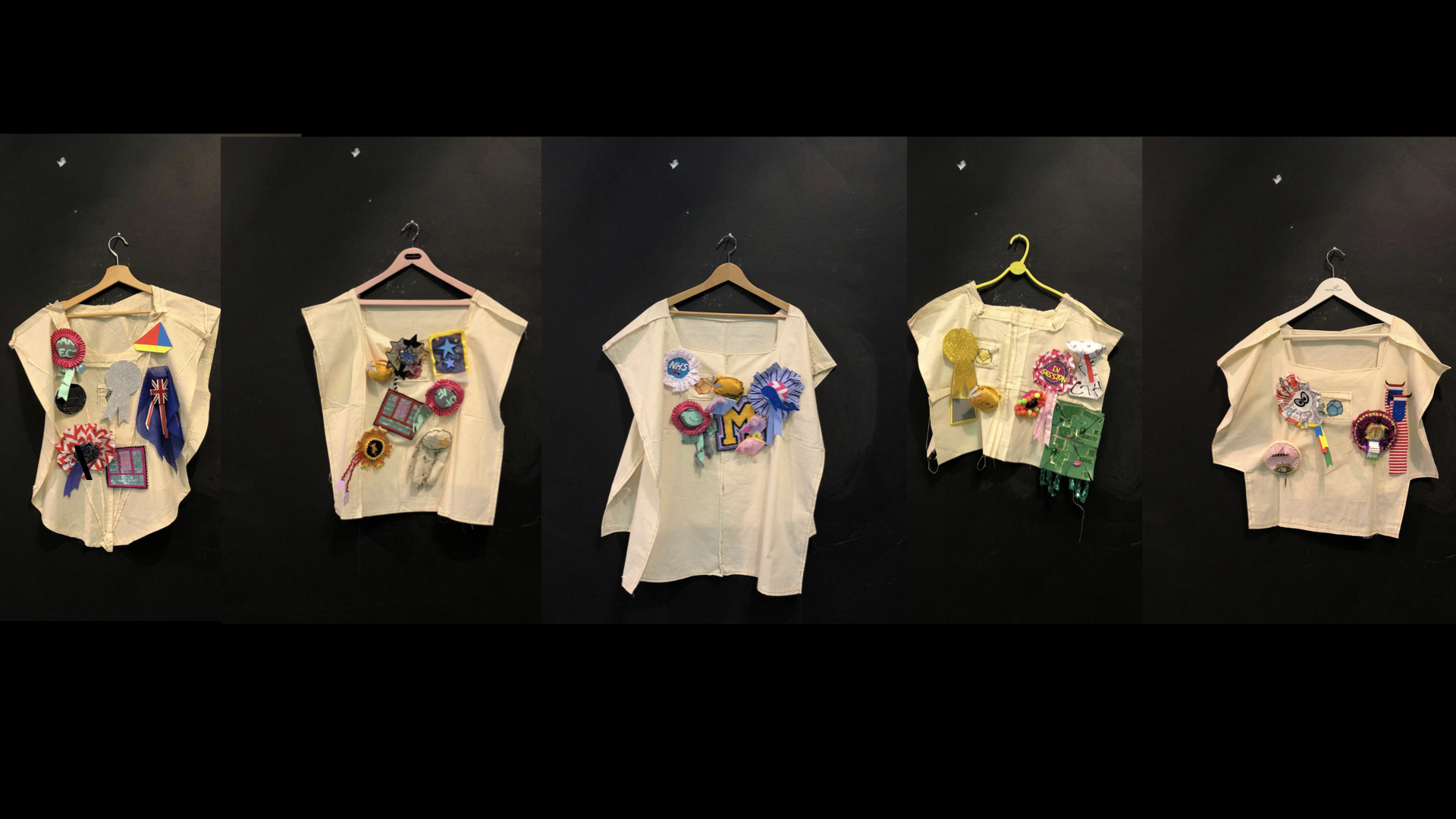
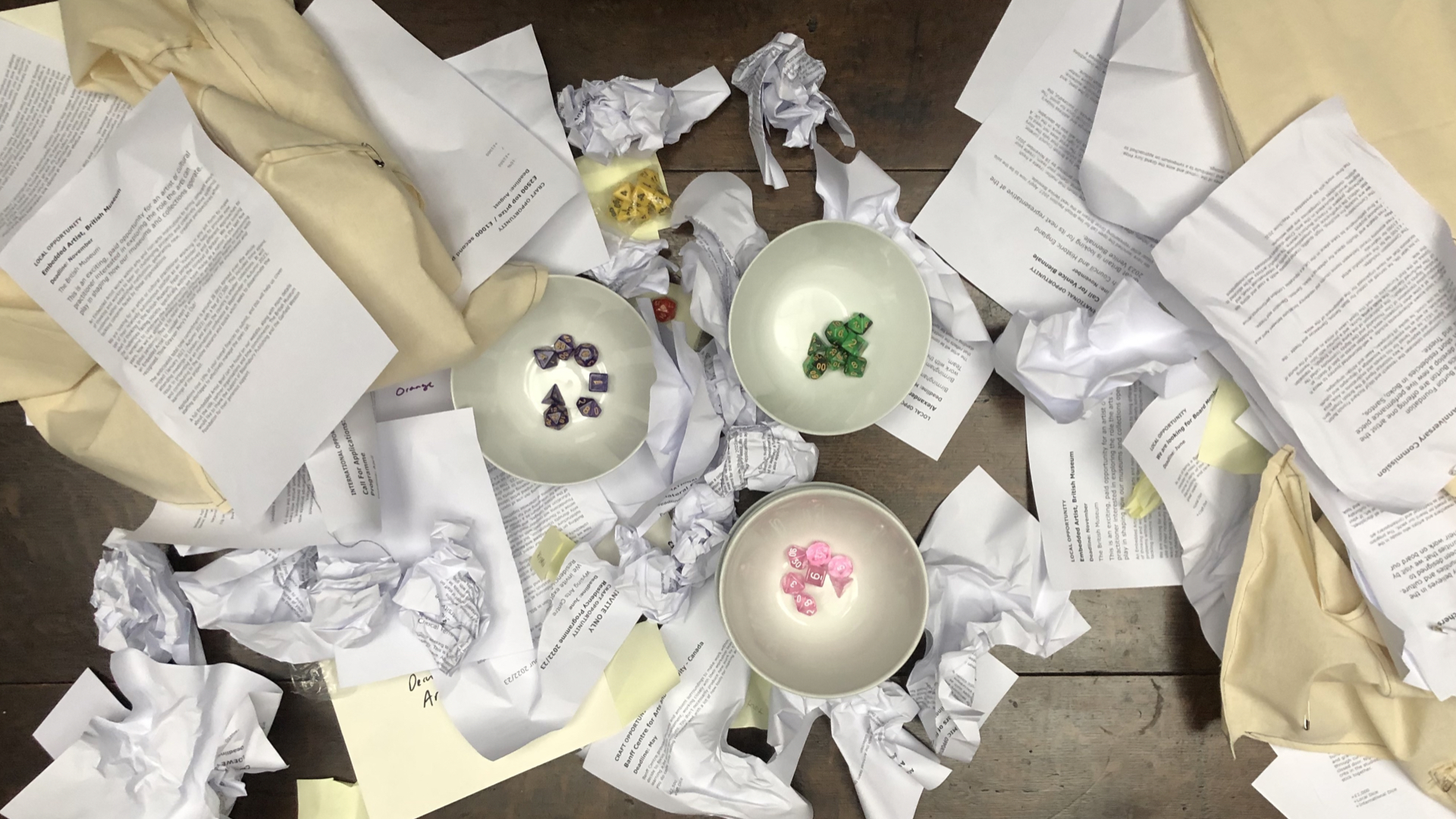
 (Embassy GRADJOB programme 2019).jpg)
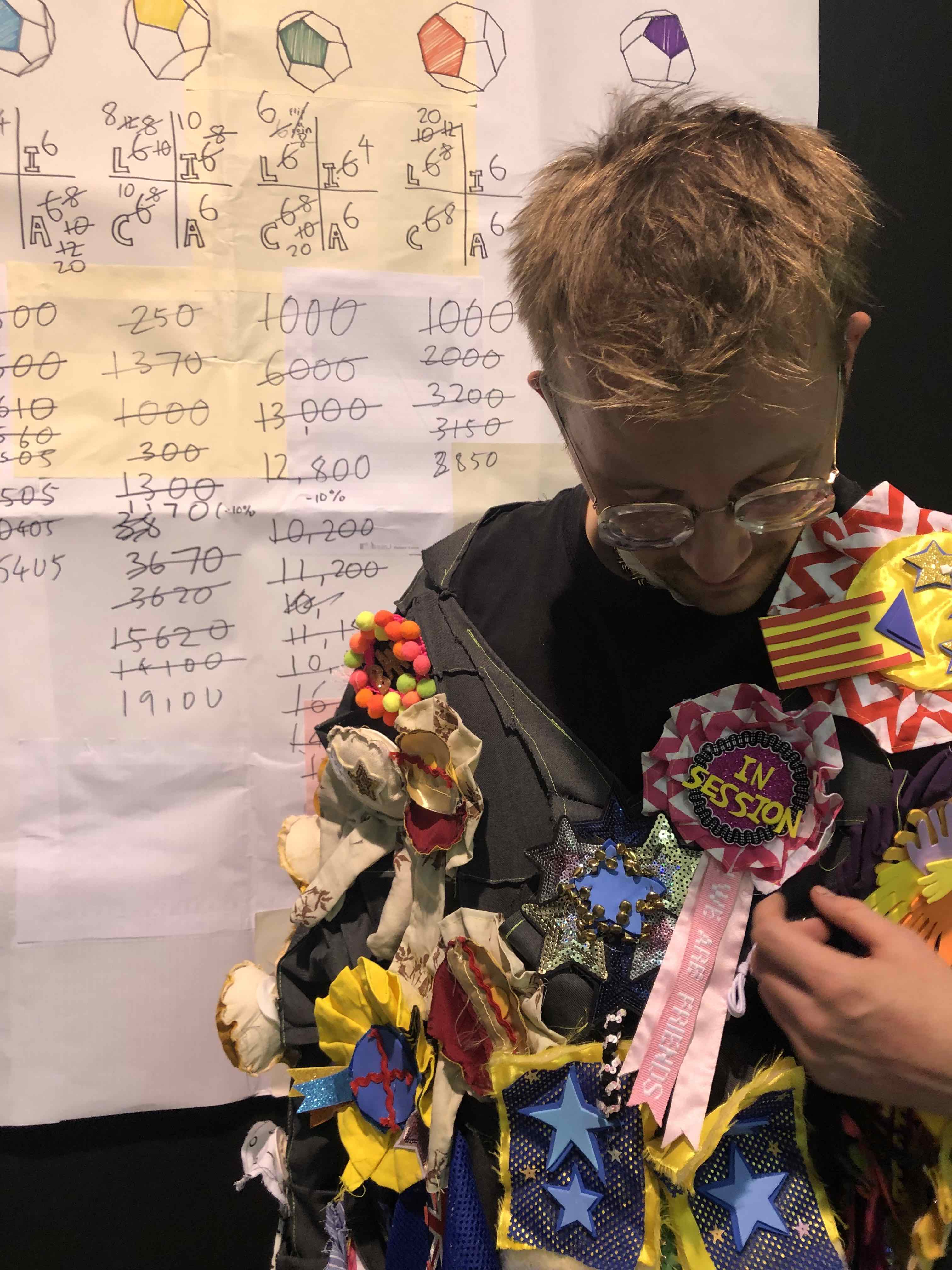
Hi all,
I hope everyone's day is going well!
I'm writing to formally invite you to the play-test of: Twelve Months: The Opportunities Dice Game (Hospitalfield Bumper Booster Pack Edition).
What is it? Twelve Months: The Opportunities Dice Game, is a roleplaying game set during a speculative year, 2022. Playing as artists navigating a shared landscape of open calls, the game intends to provoke questions around the language of opportunity, ethics of collaboration, and stratification of cultural capital. It's an educational game first and foremost, and in the past has been performed with recent Scottish Art School graduates at Edinburgh Sculpture Workshop and Basic Mountain (with GRADJOB, Embassy Gallery, Edinburgh, 2019, 2020); and upcoming with Transmission, Glasgow (as part of In Session's programme, 2021).
Are you interested? If you're interested in being involved, please let me know :) The game will take place in the Picture Gallery at 7:30pm this Wednesday (29th September), and last approximately one hour, with an optional reflective conversation afterwards. The evaluation will involve a group conversation around the themes and mechanics of the game. I will also have three questions that I'd like to pose as stimuli that will help develop the game for future play-throughs.
Players The game needs 6 players minimum, and has no maximum. Ideally we will have 12+ players so that we can play in self-selecting teams. This invite is open to current residents, Hospitalfield team, and the visiting Wysing Arts Centre team (Cicely can you please forward this on to them?)
Hopefully see you there! Gordonx
22.02.22
Hello Readers
Our names are Gordon Douglas and Cicely Farrer and we are working on a research project on performance art and its supports, called Good on Paper.
As part of this project, we would like to invite you to re-imagine cultural resources for performance-making in Scotland with us. Good on Paper intends to generate fantastical ways of organising interdisciplinary art-making in Scotland, beyond the restrictions of feasibility. We’ll be realising ideas as scores, texts, blueprints–– things that write their promises on paper first.
When speaking with friends we sometimes describe the project as looking towards a ‘LUX Scotland for Performance’, or a ‘Scottish Live Art Development Agency’. Although these comments are (somewhat) in jest, they’ve been helpful in noting the limited resources dedicated to performance art development across Scotland. As artists we frequently move/slip between visual arts, theatre, music, and dance opportunities and so, the limited space for performance art felt very acute during Covid-19.
Let’s re-imagine performance art in existing arts economies and ecologies!
What is performance art?
Over the summer last year we tried to answer this, writing definitions of performance art every day. A diary of sorts: how we felt about performance, how we felt we were performing. The language we used in these diaries was imbued with morality: e.g. ‘good’ performance = candid, solid, captivating, sensical. And when talking about performing bodies, recurring ideas of ‘quality’ or ‘craft’ presented exclusionary barriers around ability and training.
Is performance art a language?
performing to revolt, to maintain, to compose & to entertain?
Questions also emerged around how (and why) a sweeping term like ‘performance’ might swallow all of these approaches up? Performance as the magic word. Can we imagine and write new ways for how organisations might perform in the interests of performance?
We would like to explore these questions and limitations of language with you.
Performance & Language, the first of our three closed-group events, is a space for communal thinking about the ‘language’ of performance and how it is made legible (or not) in contemporary art resources in Scotland. Language as scoring, bodily knowledge and vocabulary. This workshop will take place on Zoom 27 March, 11am-1pm. A small access/attendance budget is available—more information through the link below.
Good on Paper: Workshop #1
We hope to hear from you soon,
Yours, Gordon and Cicely
This letter is 2500 characters and appears on MAP and Creative Scotland Opportunities.
Good on Paper is a research project initiated by Gordon Douglas and Cicely Farrer looking into the futures of performance art making in Scotland. They are working with MAP Magazine on a series of texts through spring/summer 2022.
Several Studies on Good Fortune, is a working edition designed by Gordon Douglas. It is shared as part of Good on Paper (2021-23), a series of interviews, group thematic dialogues, and late night unregistered chats looking to fantastical future resources for performance art making across Scotland. The project was coordinated by performer Gordon Douglas and curator Cicely Farrer.
The studies overleaf include: scans and reprints of learning tools used between the two coordinators; invites circulated to prospective attendees of the group discussions; preparation materials that host contingencies for interviews; and new constructions devised to catch untethered thoughts at threat of being lost.
The folded design used throughout the edition borrows its form from the childhood schoolyard ‘fortune-teller’– a makeshift paper device that seeks to offer detailed impressions of a player’s future and perhaps some supernatural advice towards helping them attain their desires. This application was primarily made popular in the 1950s in the UK, where the device was believed by schoolchildren to uncover what famous person they would marry, how many children they’d have, what kind of house they would buy, or what kind of profession they’d secure. The use of the device as a divining instrument possibly stems from its employment within Himmel oder Hölle (Heaven or Hell), a game from the german-speaking world that saw players arrive at their destination with one of the the two possible holy judgements.
Originally, the design was described in the early 19th century as the Salznapchen (a Salt Cellar) created by turning the device upside down and using the finger pockets as vessels to hold salt. The form was foundational in Friedrich Fröbel’s Forms of Life, being a shape from which other structures and characters could be derived. As one of several ‘occupations’ alongside Fröbel’s ‘gifts’, Falten (paperfolding) was integral to the learning through open-ended play that characterised the Kindergarten model that he founded, and that was globally adopted and circulated from the 1840s onwards.
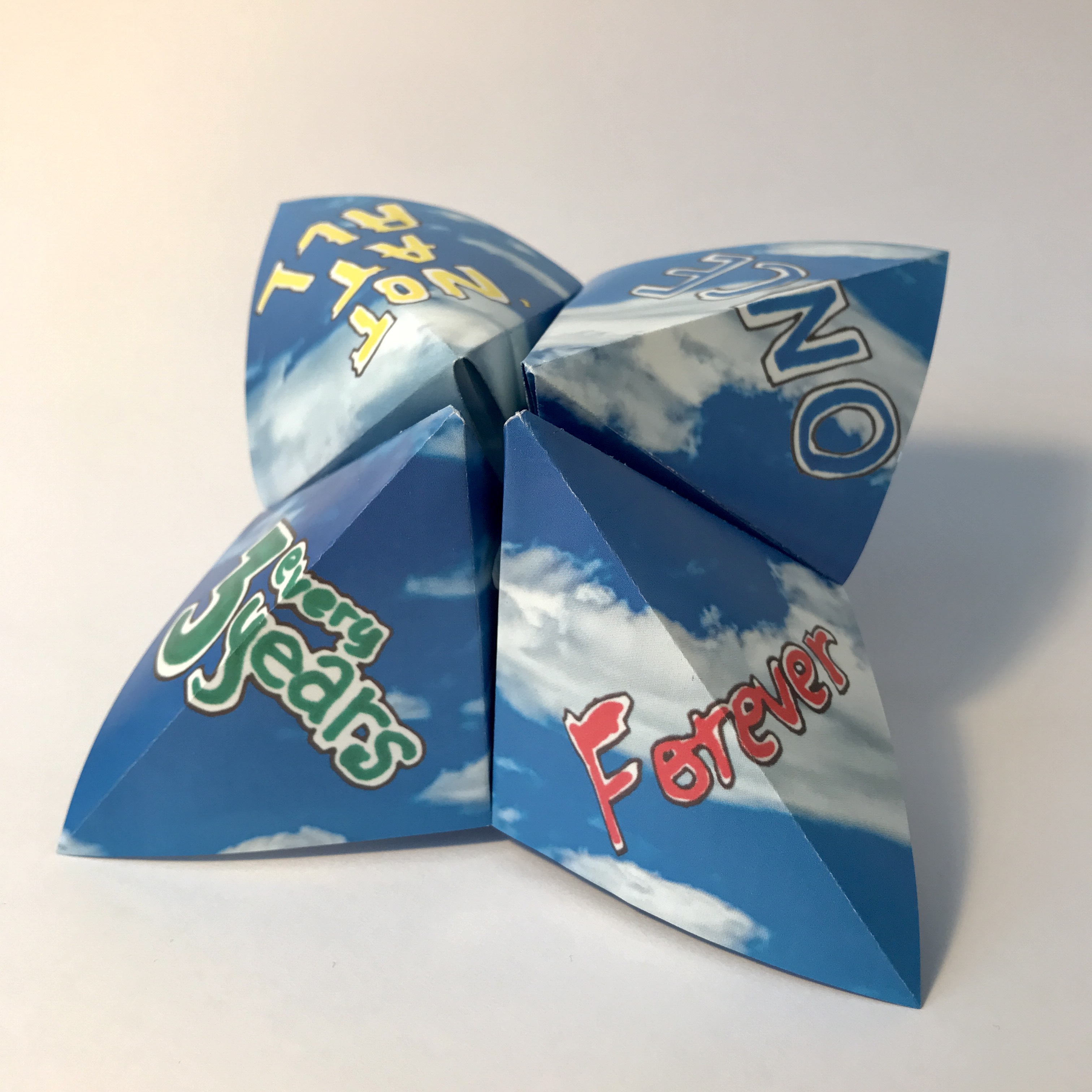
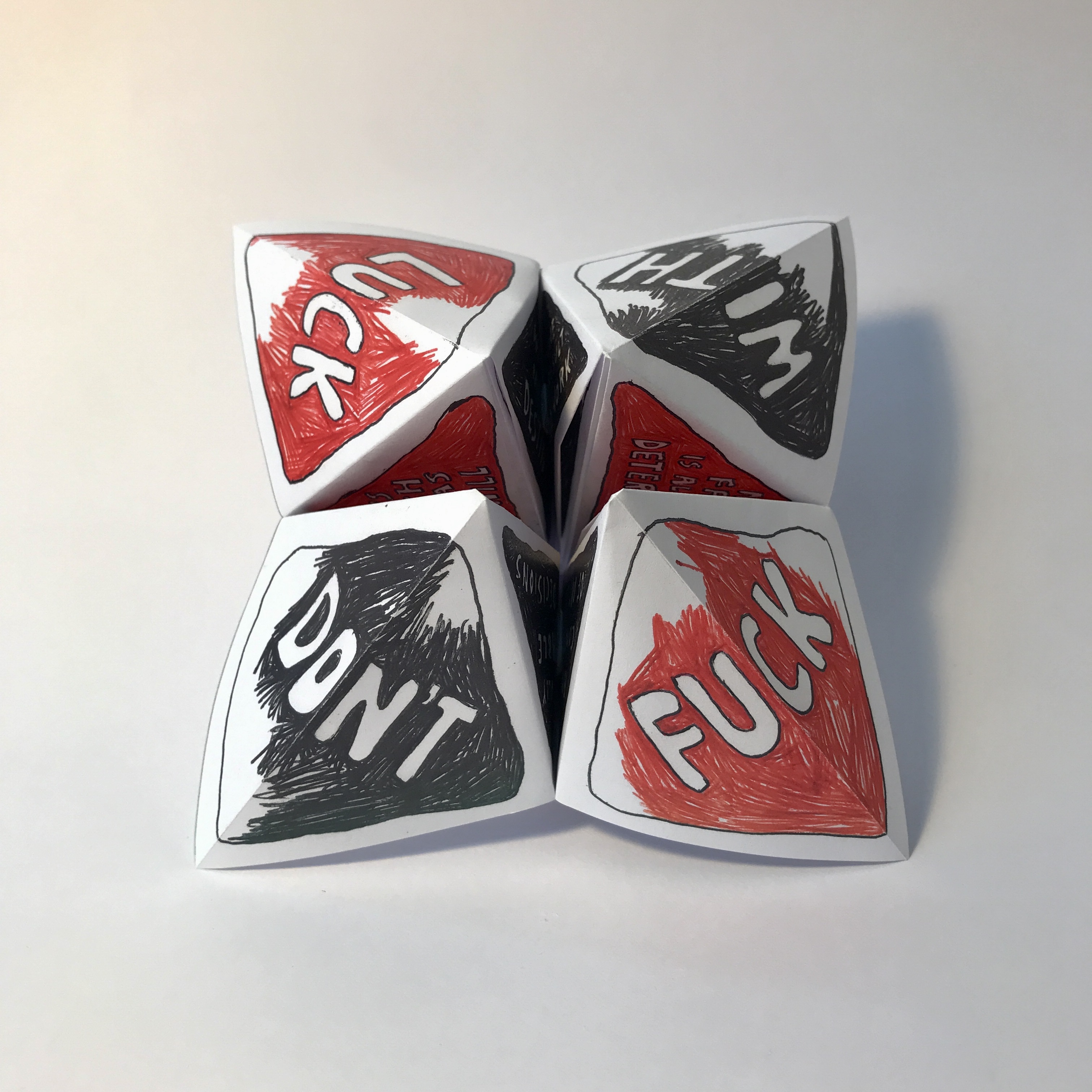
In the year 2525, Good on Paper celebrates 500 years since it became a fully fledged institution—its protocols, workflows, humans and habits, settled into a comfortable eternity. Performance art is different now and everybody does it. Broadcast as single tones between the earrings we all now wear, pulsating pitches and lengths carry instructions for the factory chips installed in our temples on our 16th birthdays. ‘READY READY READY! READY FOR PERFORMANCE ART!’, we howl in a circle (as is now custom) while the Good on Paper accredited doctor guides the chips’ teeth curling into the skin. Then the teenager screams, ‘I AM A PERFORMANCE ARTIST’, as the performance art they’ve been working on for their exams is transmitted across the network.
In the year 2263, the paper is our support, blank slates measuring 297 x 210mm fold us into a pulp. Inside: a moebius strip of barren potential, some quick pinches into paper aeroplanes first, then into fortune tellers teasing an endless game in the rain. As seasons change, the papier maché we made when we lounged around in our paper bedding stiffens, drying out and igniting in a blisteringly hot summer. We pull the landscape in, tucking and crimping mountains of the stuff to isolate the blaze in a single envelope. Global origami rolls back in for another day.
In the year 10191, aliens from the scissor planet attack in scissor-shaped spaceships. Good on Paper are drafted as Chief Recruitment Office for the high performing military operation planned to protect our vulnerable flat world. Scores of infantry with paper swords take formation in defence of our burgeoning library-metropolises. Good on Paper is confident, but the scientists are worried about prospects. The first wave is a shocking blow to our morale as our extra-stratospheric paper shields are snipped clean in half. Things don’t look good. One of the scientists, an outcast, remembers reading a myth that under the page we stand on was something tough, a round, 3-Dimensional substance that some had understood as a world before. Like a stack of paper, but stronger and uncuttable as if paper had calcified. An elite team of paper planet’s finest now look down now into the vertical horizon, under the structures that our civilization founded itself on: a world built of contracts, receipts, passports, invoices, bank notes, certificates, annulments, agendas, dreams. Digging deep into the mounds of paper, the specialists note a thickening, a stretching of the flatness into a depth—something that sustains heavy and unreachable information underneath its surfaces. Like a sheet of paper with writing on the back that disappears when you turn it over. Like a book with spines on every edge that you can’t open. Was it the fabled ‘Rock’ that the scientist had spoken of? Samples are excavated and further study for military application is granted permission.
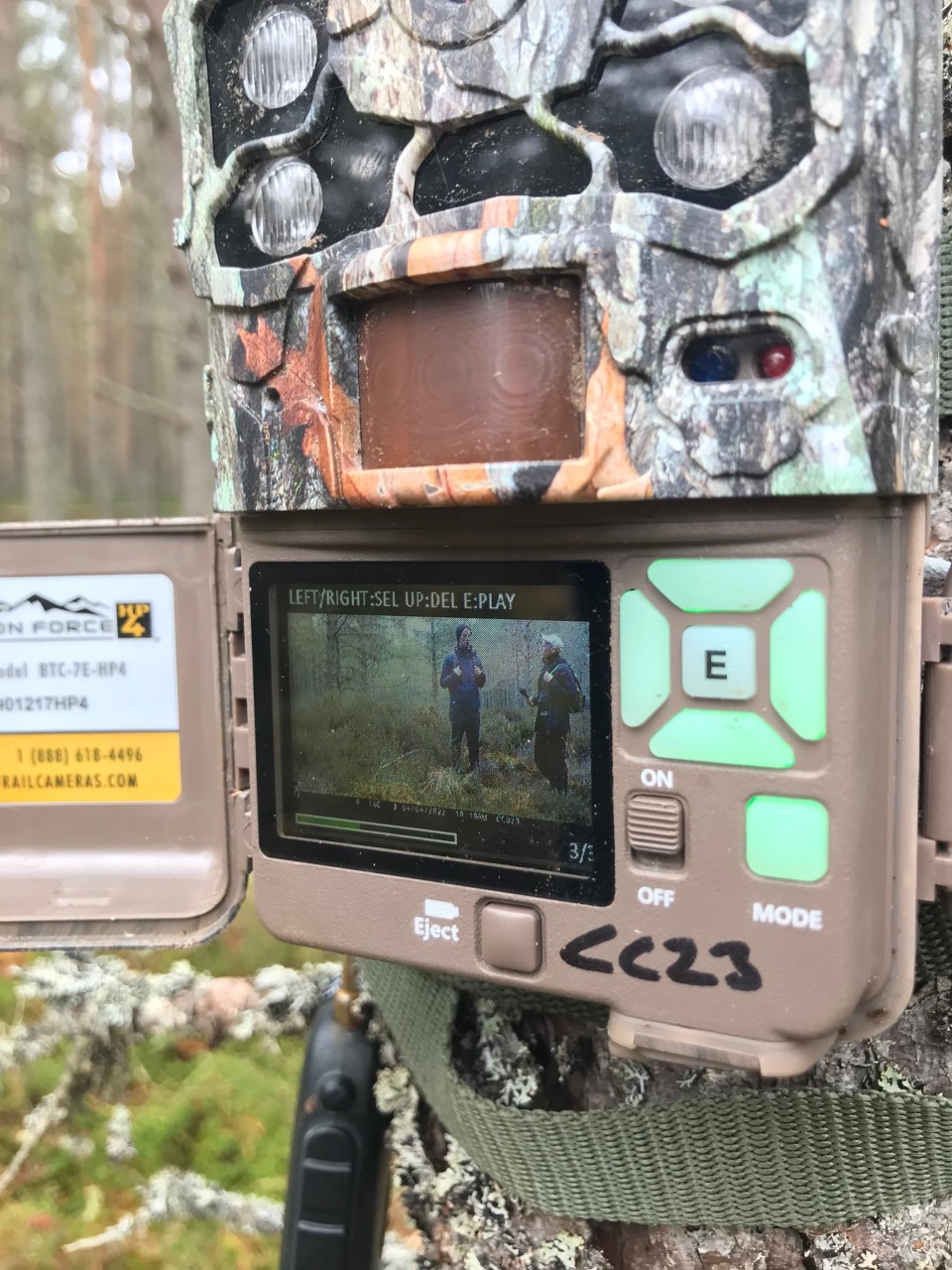
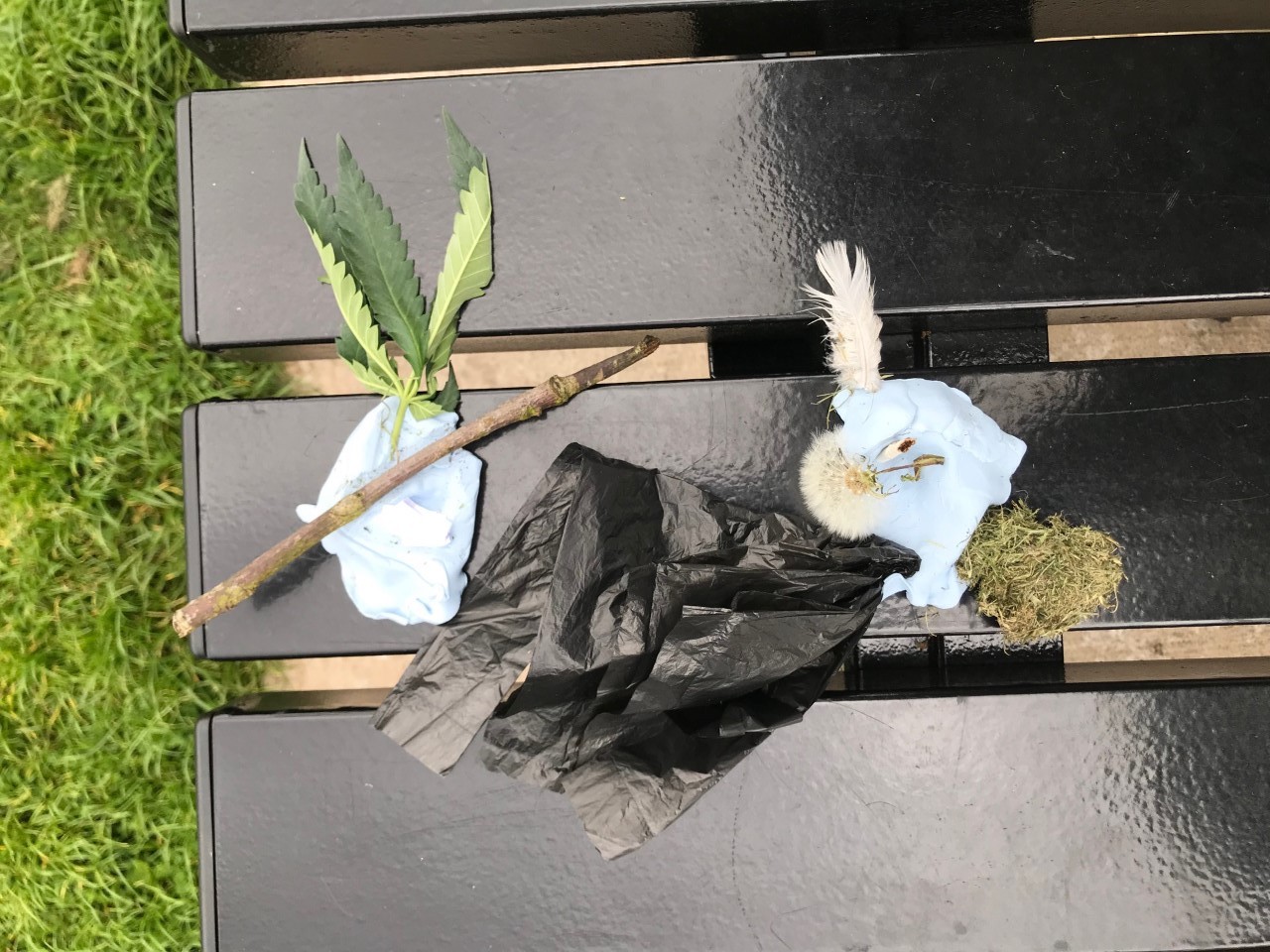
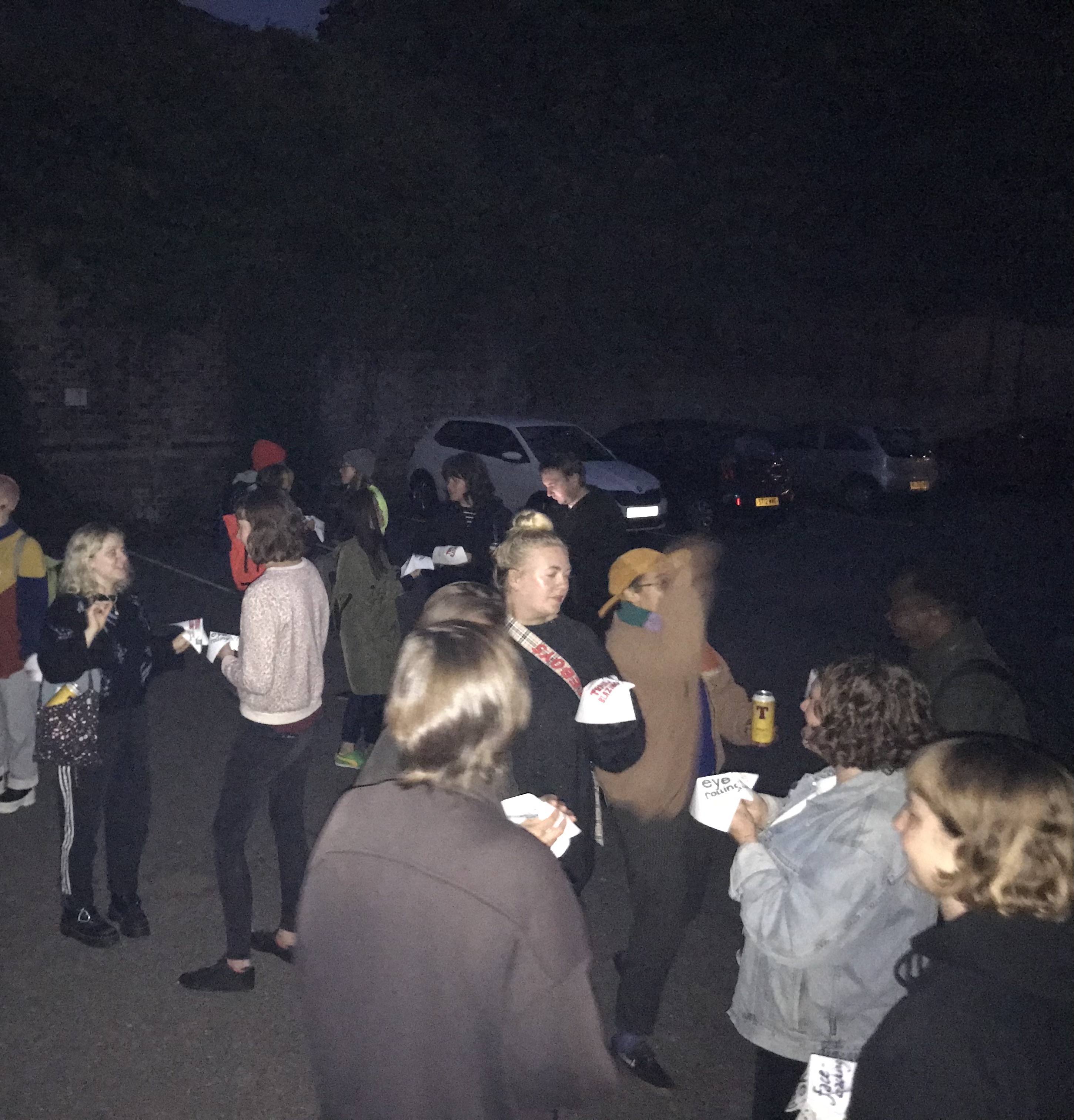
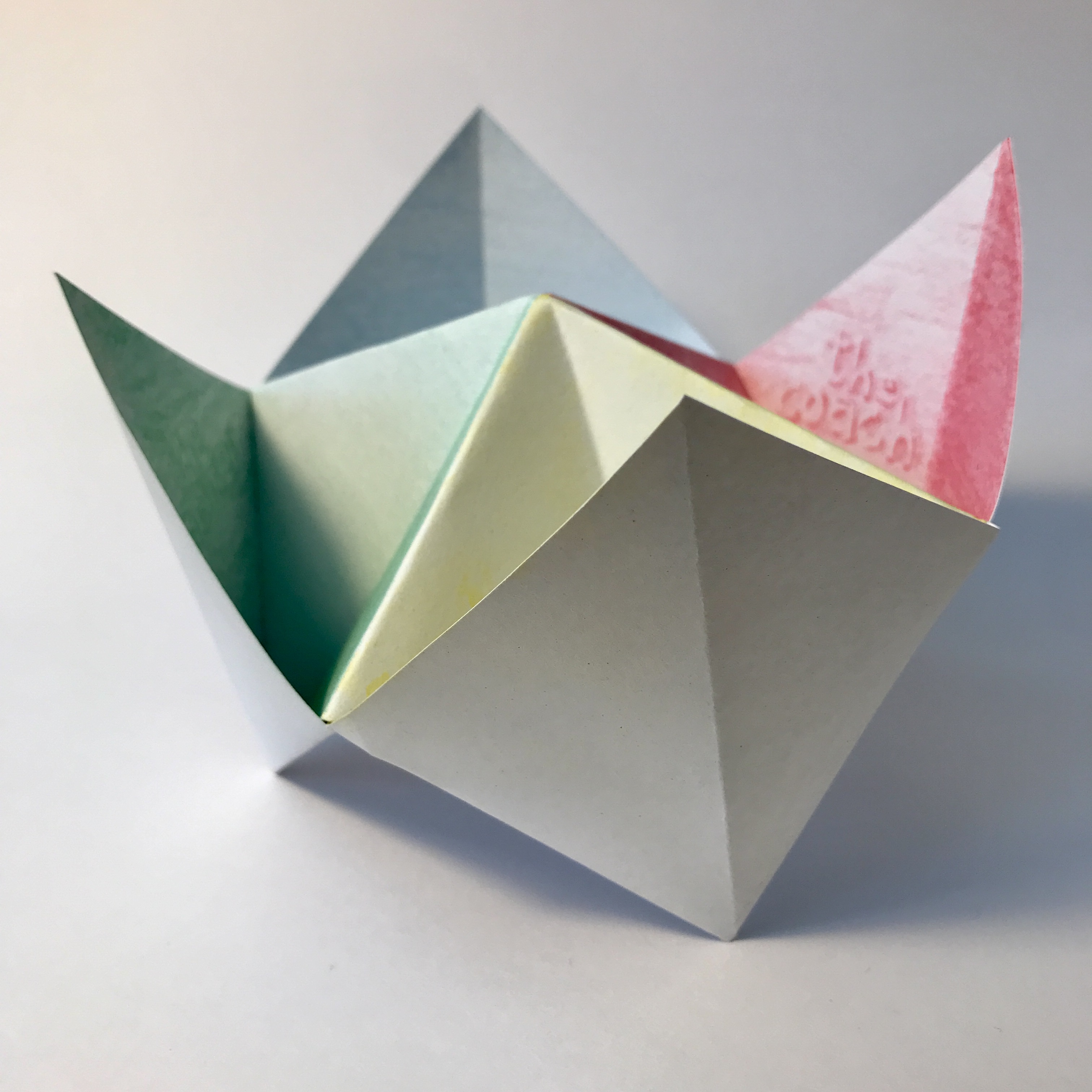
Dear Raphael Unger et. al,
My name is Gordon Douglas, and I am a performer from Scotland. Apologies in advance for any typos or grammatical errors, I am using Deepl to translate. I am writing today to submit an application for use of the Aula, and the lobby space just outside the Aula, for the site-specific performance and installation work HARVEST.
Since January 2023, I have been working towards my Diplomaustellung with a game that engages in the exhaustion of paperwork, alienation of bureaucracy, and the seeming inculpability of people within systems performance. The work has been tested and devised for the Aula and its preceding antechamber, utilising existing technical features of the room, architectural characteristics and the flow they engender, and the entrance location of the Akademie within its development. I would be grateful if I would be able to locate my performance here throughout the duration of the Jahreaustellung 2023, to best example my practice for my diploma show and to fully engage with a new and exciting Akademie public.
HARVEST is a waiting room; two doors leading to somewhere desirable; endless registration forms; and an apologetic, part-time clown working as an attendant. The performance invites audiences into a war of attrition as they attempt to secure access to a game supposedly taking place inside the Aula, AdBK, described to them as the Jahresausstellung project of artist and performer Gordon Douglas. To gain entry, they fill in form after form, analysed for consistency and position of character, and usually rejected under baseless reasons or minute errors. By the water- cooler, in the misprints, and in the clues left behind by those before them, they find ways to cheat the system (and also perhaps find joy in the game mechanics of the paperwork). Beyond the doors: a wall of cheer; an automated spotlight; two motorised curtains; and the part-time clown’s other gig.
The project is supported by Deutsches Spielearchiv Nürnberg, through a research residency on- site at their archive in Pellerhaus; and if successful in securing the Aula and space outside the Aula, they have agreed to host it within their organisational programme within the Digital Festival Nuremberg 2023.
In the following application to the Bewerbung fur Außenarbeit Jahresausstellung 2023, I set out to offer a description of my artistic concept; breakdown of the installation and performance being presented accompanied by further supporting images; an, illustrative plan for install and performance times; and proposed installation, based on feedback from preliminary correspondence with Hannes Rösler; and a short artist statement.
If you have any further questions please do not hesitate to get in contact.
Yours,
Gordon Douglas (MA Live Art Forms)
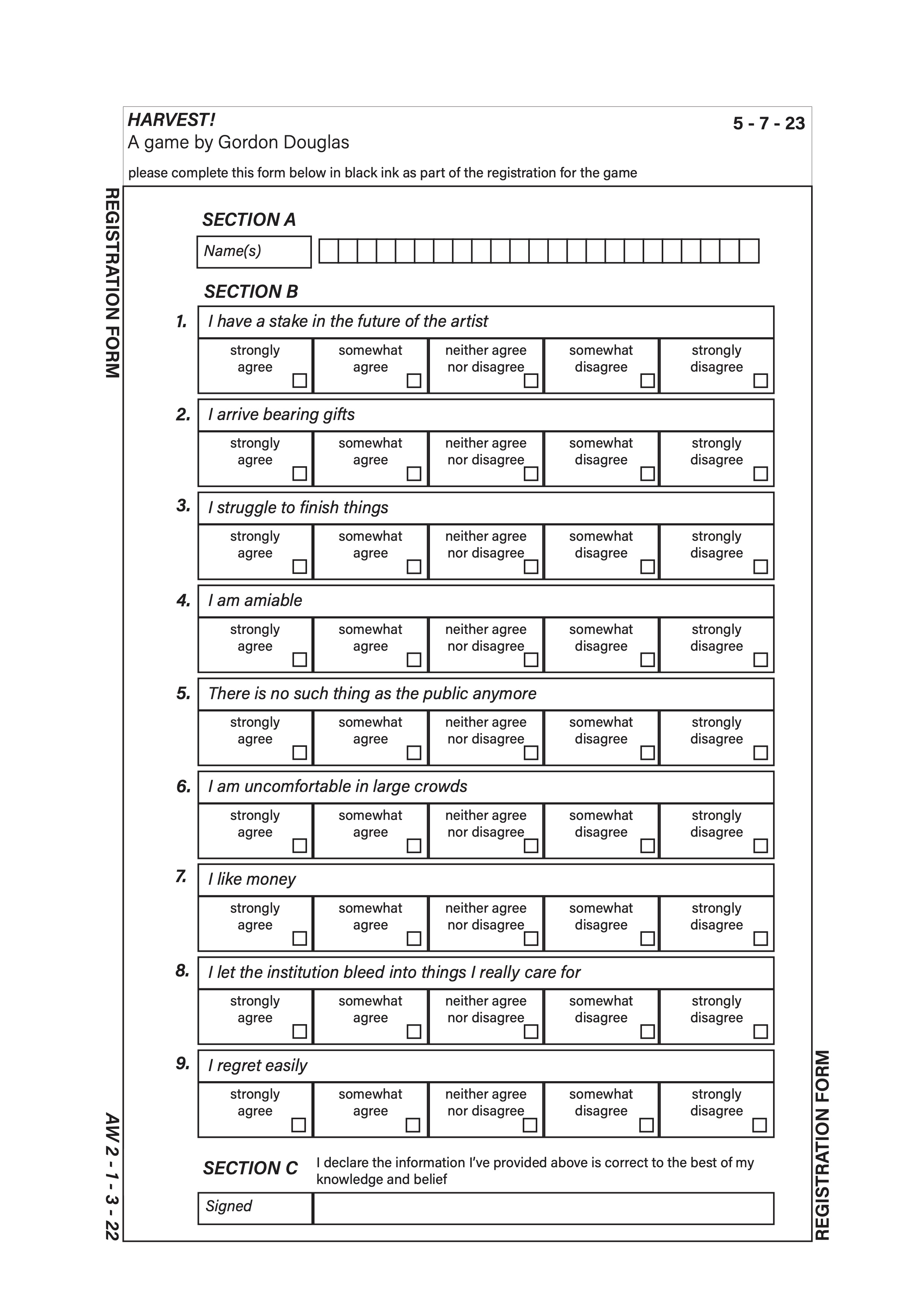
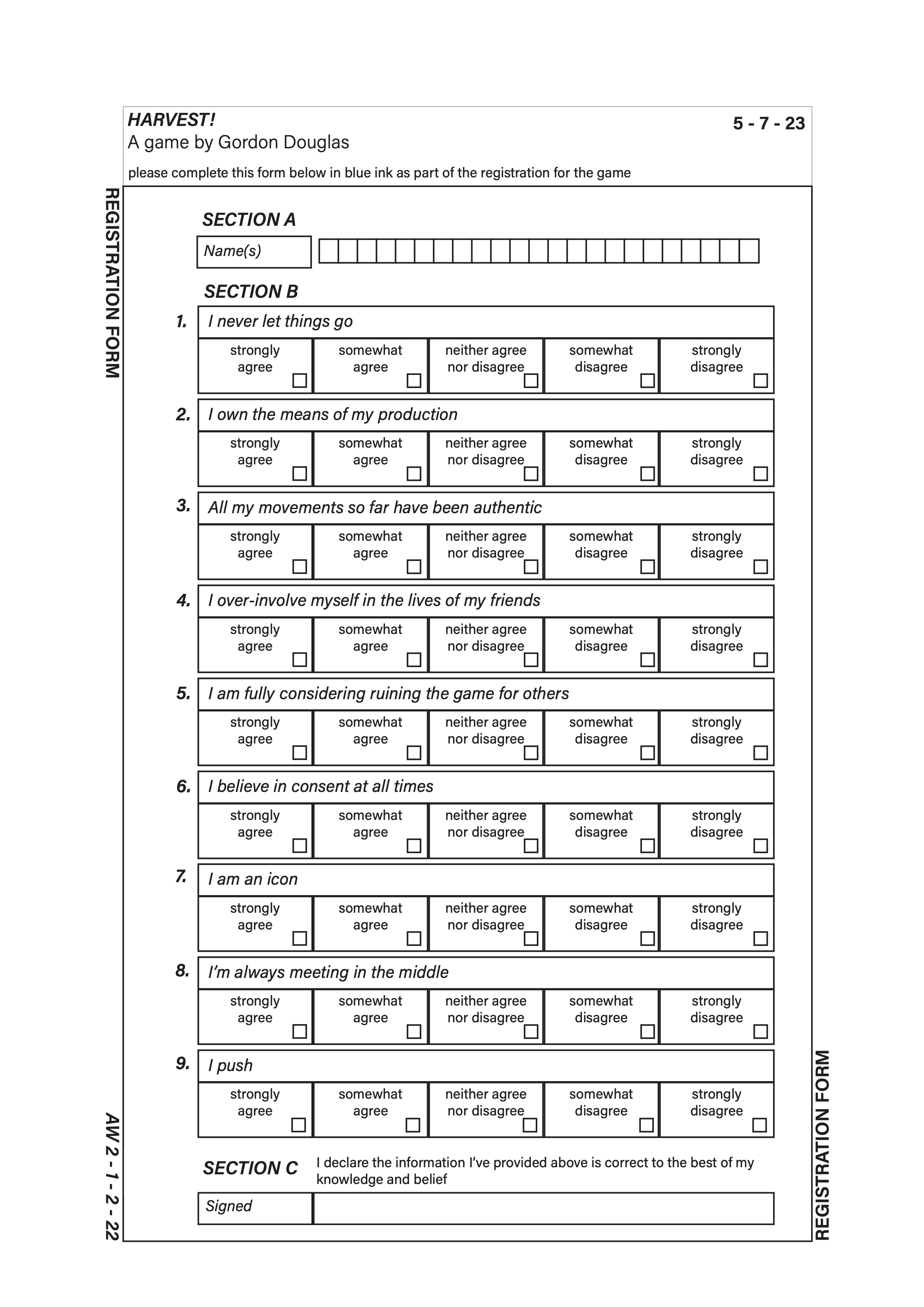
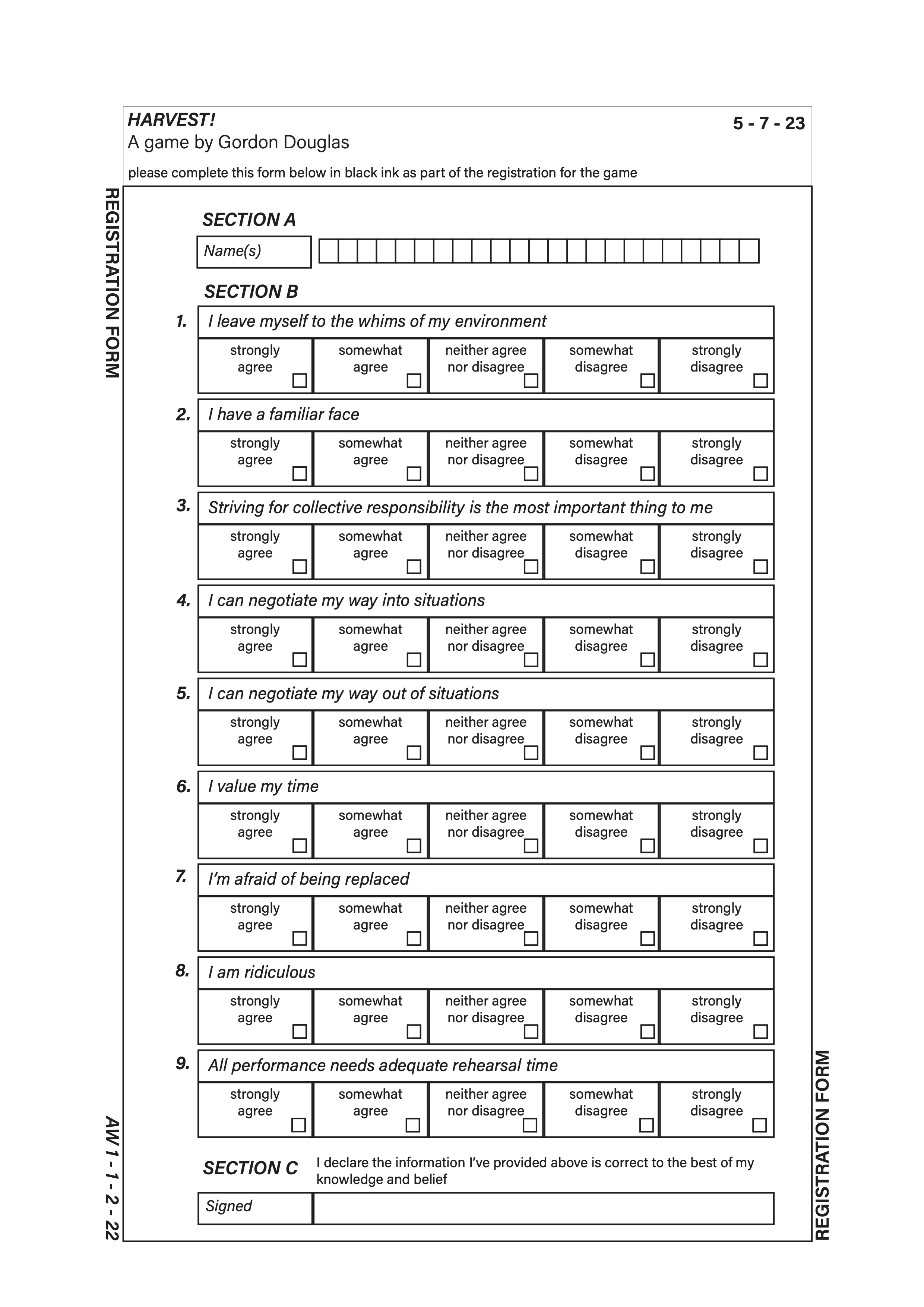
departments
IN ANTICIPATION OF TWO WORKS. Leaving & entering.
[10:10:00] We used to sign off our shared email account with everyone’s names. It was always in the order of who had committed to the organis(z)ation the longest, and over time, I saw my name edge left– from last to second position. There was never any specific training– we just learnt on-the-fly– but the order of our names indicated who might have had the most authority at any given moment, or at least the acquired experience when contributing to this busyness.
[18:06:06] In 2015, we stopped writing our names, instead signing off with only the name of the busyness. I felt sad because I liked being part of it, and I liked people knowing I was part of it. When you proposed the change, you told me it was because you were concerned about other possibilities like the “incident” repeating itself. You wanted to avoid situations where one of us was held accountable for the community we attended to, rather than the community itself taking the blame. The name of the organiz(s)ation would shield individuals from the conflict we evoked.
[21:09:13] You were worried of course, because, after all, we were aspiring 20-something year olds, who had agreed to be legally and financially liable for the solvency of this busyness. We accepted roles that were perpetually junior, and also in control of the world. I suppose, there’s a somewhat soothing quality to the detachment I noticed: If one doesn’t know who to email, then send the request to the general inbox.
[00:00:00] It was fine. Then when you were assigned a new device, I remember you lost access to your personal email and started using the general inbox. I tried to keep the emails addressed to you separate from the emails addressed to us, yet you kept relying on our generic signature. The continued occlusion of your name (even from your tax records, purchases, and deliverables) frequently evaded my filtering system. I ended up not being sure if the deliveries I was administering were ours or yours, and I prompted you to open a new account and keep us separate. You said you had forgotten how to, and also that you preferred not to re-learn (or to unlearn) at this elevated stage, instead further connecting up your platforms, health tracking, and subscriptions to the legible registers of the organis(z)ation.
[10:09:59] People didn’t know who was in charge, and informally, it meant I got asked a lot about who was still working on the project. Sometimes, I even forgot. We were deliberately trying to be less visible, and I remember it changed things. As individuals, we remained silent during the decommissions, when routines were taken out of context, or agencies spilt milk. Others did the same, holding on to the antiquity of professional practice whilst trimming their skill trees. Supervisors encouraged it, because frankly, on the other end of the emails there’s a family of juniors too.
--
HARVEST (Gordon Douglas, 2023) welcomes audiences into intimate negotiation with an apologetic, part-time clown as they attempt to secure access to what’s behind a mystery door. In the paperwork vertigo, players cling to streams of registration forms, gathering information passed on from successive generations of players, and activating shared tools in secret. Our clown will attempt to uphold this unjust system to the best of his ability, however no promises can be made at this time. The development of this play-test is supported by Deutsches Spielearchiv, Nuremberg.
The Sleeper Cell (Jan Kunkel, 2023) traverses thresholds between employable management and embedded maintenance. Building upon sculptural instances, the substitution of “studio” with “office” (and vice versa) elicits a ubiquitous social contract. As audiences witness ruptures with the terror of the voice within, processual tracings of phantom presences unravel. In gestalt of short-circuited recursivity, a tender intruder embarks to circulate leaked footage from work environments, swamp content and devilish distractions.
–
Gordon Douglas is closely invested in comedies and tragedies playing out in complicity, and invents games to have fun exhausting these with people. https://gordondouglas.org
Jan Kunkel is dwelling on the messy interstice between libidinal and political economy. Jan co-initiates the art space PlusX (+X). https://xplusx.xyz
 photo credit: Johannes Kersting
photo credit: Johannes Kersting
Gordon Douglas is engaged in the mechanics of art worlds, sharing his research primarily through games and play-tests. He is introduced with terms like ‘social resident’, ‘performative auditor’, ‘lover of the institution+++’, and ‘critical friend’, and invests heavily in the comedies and tragedies of interdependent professional life. Gordon is a performer from Scotland who devises long-term embedded positions and unannounced events that set out to re-write organisations. He is currently based in Beijing.
This website hosts documentation from previous work; emails and text messages amongst collaborators; drafts of collectively-written press releases; and excerpts from the many packaged submissions that answer to opportunity.
you can contact Gordon via gdouglas90(at)hotmail(dot)com
